Glossary of Places, People, Practices
and Other Special Terms Used on This Website
currently 298 entries

From 1972 through 2008, Adi Da made thousands of unprecedented communications about the nature of Reality, the Divine Revelation He offers to all, and the Way that enables all to Realize what He is Revealing. The inadequacy of conventional English for expressing these communications led Adi Da to develop a large body of specialized terminology designed to be up to the task of making (and simplifying) these communications — in much the way that scientists develop specialized terminology in their fields of expertise. The articles, stories, and audio/video clips on this site often make use of Adi Da's unconventional terminology. For this reason, we indicate such terminology with a double line under a word or phrase that looks like this. When you hold the cursor over such a doubly underlined expression, a window will pop up, containing a glossary entry for that expression. If you move your cursor into the window, it will "solidify" in color. If you move your cursor outside the window, the window will disappear after a short time. You can also reach this glossary with all the entries in one place, by clicking on the link, "MORE GLOSSARY ENTRIES."
Besides specialized terminology, our glossary also contains entries for people (e.g. Chögyam Trungpa), places (e.g., Adi Da Samrajashram), books (e.g., the Bhagavad Gita), etc. associated with (or relevant to) Adidam. |
 Acausal — Neither "caused" nor "causing", therefore, Existing Beyond and Prior to the realm of duality in which the law of "cause-and-effect" is operative. Adi Da uses this word in both His descriptions of the nature of Reality and of the Way of Adidam. The Nature of Reality. In phrases such as "Real (Acausal) God", Adi Da indicates that God is not the "Creator" of conditional existence or in charge of conditional existence ("causing" this or that effect in the world). Rather, God (or the Divine Reality) is the Source in which all apparently separate "beings" and "things" are arising; God is the Consciousness of which all apparently separate "beings" and "things" are the modification. The Acausal Way Of Adidam. Adi Da also uses "Acausal" (as in "Acausal Adidam") to indicate that Divine Grace and Realization in the Way of Adidam is a free gift to the devotee, not something that is the result of a cause and an effect. It is an awakening from an illusion, which is not the result of cause and effect processes "within" the illusion, but rather, due to prior coincidence with and devotion to the Awakened State Itself (and the transcendence of the ego-act which perpetuates the illusion). What is the "cause" of the illusion of the non-Realization of Reality Itself? The "cause" of the illusion of the non-Realization of Reality Itself is the action (of self-reflexive and "self"-reflecting "self"-contraction) that is the ego-"I". . . Right and true practice of the Reality-Way of Adidam does not (and cannot) "cause" Perfect Realization - whether by "self"-effort or by any Effort of Mine. The only-by-Me Revealed and Given Reality-Way of Adidam Is the "radical" (or always "at-the-root") practice of searchless devotion to the Acausal Reality-Principle. . . I do not "cause" Divine Self-Realization. I Am Divine Self-Realization . . . Therefore, right and true whole bodily devotional recogition-response to Me Is Divine Self-Realization - or the tacit, direct, and Acausally Self-Evident Realization of Reality Itself.
"Acausal Adidam", Part 10, The Aletheon |
Adi — Sanskrit for "first", "primordial", "source" — also "primary", "beginning". Thus, most simply, "Adi Da" means "First Giver".
| Adi Da Samrajashram — The Island of Naitauba, which is the Sapta Na Sannyasin Hermitage established by Adi Da Samraj in Fiji. (Previous names: Adidam Samrajashram, Sri Love-Anandashram, Purnashram, Translation Island.) More can be found here. | |  |

Advaita Vedanta — The Sanskrit word "Vedanta" literally means the "end of the Vedas" (the most ancient body of Indian Scripture), and is used to refer to the principal philosophical tradition of Hinduism. "Advaita" means "non-dual". Advaita Vedanta, then, is a philosophy of non-dualism, the origins of which lie in the ancient esoteric teaching that Brahman, or the Divine Being, is the only Reality.
Advaitic — "Advaita" is Sanskrit for "Non-Duality". Thus, "Advaitic" means "Non-Dual". Avatar Adi Da has Revealed that there is not the slightest separation, or "difference", between the Unconditional Divine Reality and the conditional reality. In other words, Reality altogether is Perfectly One, or Non-Dual, or Advaitic.
Agency — In the following passage (from Sutra 10 of The Dawn Horse Testament), Adi Da elaborates on what He means by "Agency": ...(Even After, and Forever After, The Avataric Physical Lifetime Of My Bodily Human Divine Form), I Will Remain (Thus, and Inherently Most Perfectly, and Most Directly) Effective By Means Of The Continuous Work (or Always Me-Extending Agency) Of My True (and Formally Acknowledged) Agents, Which Agents (or Unique Means of Agency) Consist Of My Avatarically Self-Revealed (and Always Me-Revealing) Divine Word, My Avatarically Self-Revealed (and Always Me-Revealing) Divine Image-Art, My Avatarically Self-Revealed (and Always Me-Revealing) Divine Leelas, and The Formally By-Me-Transcendentally-Spiritually-Empowered Ruchira Sannyasin Hermitage Ashrams.
Therefore, Now (and Forever Hereafter), My Every Devotee Will Be Given Appropriate Access To My Avatarically Self-Revealed Divine Word, My Avatarically Self-Revealed Divine Image-Art, My Avatarically Self-Manifested Divine Leelas, My Avatarically Given Divine Sign, and All My Avatarically Given Divine Spiritual Blessings (As These Are Preserved, and, Otherwise, Transmitted, Within The Serving Culture Of All The Formally Acknowledged and True Instruments Of My Avatarically Self-Manifested Divine Spiritual Work). . . . and The Realization (By Means Of My Avatarically Self-Transmitted Divine Transcendental, Spiritual Grace) Of My Inherently egoless (and Self-Evidently Divine) Person (Which Is The Inherently Perfect Self-Condition Of all-and-All, and Which Is Also, or Inherently and Necessarily, The Inherently Perfect Source-Condition Of all-and-All) Will, In This Manner, Always Continue To Be Served By My Great Avatarically Self-Revealed Divine Means. |
Note: Adi Da Samraj often uses "Agency" and " Instrumentality" as complements of each other. The creation of sufficient Agency and Instrumentality has been Adi Da Samraj's primary means for replicating His Pattern here and thereby ensuring the survival of Adidam in perpetuity.
Aham Da Asmi — The Sanskrit phrase "Aham Da Asmi" means "I (Aham) Am (Asmi) Da". "Da", meaning "the One Who Gives", indicates that Avatar Adi Da Samraj is the Supreme Divine Giver, the Avataric Incarnation of the Very Divine Person.
Avatar Adi Da's Declaration "Aham Da Asmi" is similar in form to the "Mahavakyas" (or "Great Statements") of ancient India (found in the Upanishads, the collected esoteric Instruction of ancient Hindu Gurus). However, the significance of "Aham Da Asmi" is fundamentally different from that of the traditional Mahavakyas. Each of the Upanishadic Mahavakyas expresses, in a few words, the profound (though not most ultimate) degree of Realization achieved by great Realizers of the past. For example, the Upanishadic Mahavakya "Aham Brahmasmi" ("I Am Brahman") expresses a great individual's Realization that he or she is Identified with the Divine Being (Brahman), and is not, in Truth, identified with his or her apparently individual body-mind.
However, "Aham Da Asmi" is not a proclamation of a human being who has devoted his or her life most intensively to the process of Real-God-Realization and has thereby Realized the Truth to an extraordinarily profound degree. Rather, it is Avatar Adi Da's Confession that He Is the Very Divine Person, Da, Who has Appeared here in His Avatarically-Born bodily (human) Divine Form, in order to Reveal Himself to all and All, for the sake of the Divine Liberation of all and All.
All and all — Avatar Adi Da uses the phrase "all and All" (or "All and all" or "all-and-All") to describe the totality of conditional existence from two points of view. In Aham Da Asmi, He defines lower-case "all" as indicating "the collected sum of all Presumed To Be Separate (or limited) beings, things, and conditions", and upper-case "All" as indicating "The All (or The Undivided Totality) Of conditional Existence As A Whole". All of us are familiar with the lowercase "all": the universe of apparently separate objects and beings. But the "All" that is the "Undivided Totality Of conditional Existence as a Whole" (or "Light" over and against "Consciousness") is not something experienced by most of us as a tangible Reality. It is a byproduct of Great Realization (particularly, Divine Realization, in which the root egoic act of separating Consciousness and Light is transcended) and occasionally devotees of Adi Da have experienced It by virtue of being in His Company (e.g., here and here). Adi Da has also indicated many times how the "All" can take a personal form that He has called "The Goddess": the subtle Personification of the Creative Universal Spirit-Energy. "She lives and is alive as everything and sometimes you can even actually have a vision of Her and see Her in human shape and form, both in Her benign and in Her wrathful aspect." The worlds, in and of themselves, are the conditionally manifested modification of What is traditionally described as the "Divine Goddess" (or "Mother-Shakti") and no one is moved to throw Her away. Every one is fascinated by Her. So the Principle of self-sacrifice is not served by the "Divine Goddess" in Her "veiling" aspect — as "Maya" (or the endlessly modified and modifying Source-Energy of the conditional worlds). The Principle of self-sacrifice is served by Me, to Whom the "Divine Goddess" (or the conditionally Manifesting Energy of Reality) is "Bonded" (as a "Wife" to the "Husband" of Her Heart) even if She does not, from your point of view, seem to know and show it.
|
Adi Da describes His relationship to "all-and-All": I Am the Truth of Reality Itself.
I Stand Prior to all-and-All — and I Transcend all-and-All.
|
Alpha and Omega Strategies — Adi Da's names for the contrasting life-strategies of the East (the inward-oriented "Alpha Strategy") and the West (the outward-oriented "Omega Strategy"). He describes them here: | The Alpha Strategy Is Based On The Tendency To Identify With The Most Prior (Transcendental, Inherently Spiritual, and Divine) Reality, or Condition, Exclusively (or In A Manner That Suppresses, or, Otherwise, Strategically Excludes, conditional Reality). And The Omega Strategy Is Based On The Tendency To Identify With conditional Reality Exclusively (or In A Manner That Suppresses, or, Otherwise, Strategically Excludes, The Unconditional, Transcendental, Inherently Spiritual, and, Necessarily, Divine Reality). |
Avatar Adi Da describes how these two opposing strategies form the basis of the quite distinct traditional cultures of East and West, and He indicates that it is necessary to understand these differences for true human healing and growth: | These Two Strategic points of view Are Apparently In Conflict With one another — and, Indeed, Historically This Has Been The Case. That Conflict Is Itself One Of The Principal conditional Signs Of human Struggle Within The Context Of conditional Nature. Thus, Early human History (and, Indeed, The Entire History Of The Total Great Tradition Of Mankind, Previous To My Avataric Divine Appearance here) Developed On The Basis Of A Dichotomy (or Split) In The Disposition Of Man, Based On The Two Natural functional Divisions Of the human brain (and Of the human nervous system). And, On The Basis Of That Split, Mankind Has Developed Along Two Entirely Different Lines (Which May Be Compared and Related To The Frontal and Spinal Lines Of the human body-mind), Almost As If Mankind Were Composed Of Two Separate Species. Therefore, This Dichotomy and These Two Great Lines Of human Development Must Be "Considered" and Understood. |
Adi Da describes how the unique Realization (and discipline) of the Way of Adidam, Revealed and Given by His Divine Grace, exceeds the Alpha Strategy and the Omega Strategy, and indeed all partial (and, necessarily, limited) views of Reality. Characteristics of the (typically Western) Omega Strategy: - emphasizes the importance of political will and human control over nature
- pursues body-based experience and scientific knowledge
- seeks to attain perfection and fulfillment in ordinary, daily life
- suppresses (or gives little regard to) Guru-devotion, mystical experience, and submission to the Divine
Characteristics of the (typically Eastern) Alpha Strategy: - emphasizes the importance of devotion, mystical experience and submission to the Divine
- pursues higher knowledge and understanding of the meaning and purpose of existence
- seeks freedom from ordinary, daily life
- suppresses (or gives little regard to) activities related to ordinary, daily life struggles and pursuits as viewed in Omega cultures
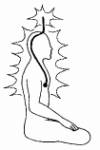 Amrita Nadi — One of the unique aspects of Adi Da's Revelation of the Way of Adidam is His complete description of the esoteric anatomy of the Spiritual process. Just as the human body has a gross anatomy (of bones, flesh, nerves, and so on), there is also an esoteric anatomy, which consists of three primary structures. Understanding this esoteric anatomy is a key to understanding what makes the Way of Adidam uniquely complete, and why the Divine Enlightenment that Adi Da Offers is an unprecedented Gift.
The quintessential structure of esoteric anatomy is what Adi Da calls "Amrita Nadi", using the traditional Sanskrit term which means "Channel (or Current, or Nerve) of Ambrosia (or Immortal Nectar)". Amrita Nadi is a radiant energy structure, the "Bright" Itself as It Manifests in the context of the human body–mind. It is the ultimate "organ", or root-structure, of the body-mind's esoteric anatomy, Realized as such in the seventh stage of life in the Way of Adidam. Amrita Nadi is shaped like the letter "S", extending from the right side of the heart (which is the psycho-physical Seat of Consciousness Itself) as its "lower terminal" through the chest, throat, and head, and then to the Source–Matrix of Divine Light infinitely above the crown of the head (as its "upper terminal"). Thus, Amrita Nadi encompasses both of the "locations" that have traditionally been sought as the ultimate Divine "place": the infinitely ascended Matrix of Light and the right side of the heart. It reflects the seventh stage Realization of Conscious Light, in joining the psycho-physical Seat of Consciousness (the right side of the heart, the focal point of the ultimate sixth stage Realization of jnana samadhi) with the Matrix of Light (the focal point of nirvikalpa samadhi, the ultimate fifth stage Realization).
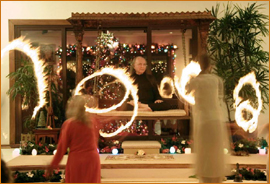
Ruchira Avatar Arati: waving lights around Adi Da |
asana — Sanskrit for bodily "posture" or "pose" — by extension, and as Avatar Adi Da often intends, "asana" also refers to the attitude, orientation, posture, or feeling-disposition of the heart and the entire body-mind.
Atma-Murti — "Atma" indicates the Divine Self, and "Murti" means "Form". Thus, "Atma-Murti" literally means "the Form That Is the (Very) Divine Self". And, as Avatar Adi Da Indicates everywhere in His Wisdom-Teaching, "Atma-Murti" refers to Himself as the Very Divine Self of all, "Located" as "the Feeling of Being (Itself)". To Commune with Avatar Adi Da as "Atma-Murti" is to Realize (or enter into Identification with) His Divine State.
Avadhoot — Avadhoot is a traditional term for one who has "shaken off" or "passed beyond" all worldly attachments and cares, including all motives of detachment (or conventional and other-worldly renunciation), all conventional notions of life and religion, and all seeking for "answers" or "solutions" in the form of conditional experience or conditional knowledge. The Avadhoot is one who is free of the soul or internal self of the body-mind. He has transcended the idea and the destiny of the self. Therefore, he is Identified only with the Radiant Transcendental Being, and his body-mind has, as a result, been set free, selfless or soulless within the dynamics of the universe.
The Avadhoot does not function through tendencies or self-development strategies within the conventional structures of the body-mind and daily life established and demanded either by worldly or religious society. The Avadhoot is simply free, and insofar as he is brought into association with the conventions of society, he acts rather unconventionally and even wildly. The Avadhoot cannot be confined or defined. He does not cling to one or the other of the opposites in any scheme of experience or possibility. His responses to others and to his own experience are spontaneous, expressing the free disposition of non-confinement by the body-mind and its relations.
In some cases, the Avadhoot becomes associated with others, who cling to his company in order to Realize the Truth. The Avadhoot may respond to those who come to him, and he Teaches them based on the qualities he finds in them. This has been my circumstance. I have lived in conventional American society and I have been confronted by ordinary people who have been bereft of the tradition and process of Enlightenment.
Because of My uncommon Condition, I have Taught as I have, in order to establish a new and living tradition and practice among those who have come to Me.
Avatar Adi Da Samraj, "Study The Avadhoot", July 13, 1980 |
Avatar, Avataric Incarnation — "Avatar" (from Sanskrit "avatara") is a traditional Eastern term for Divine Incarnation. It literally means "One who is descended, or 'crossed down' (from, and as, the Divine)".
Avatar Adi Da Samraj is also called the "Avataric Incarnation", or the Divinely Descended Embodiment, of the Divine Person. The reference "Avataric Incarnation" indicates that Avatar Adi Da Samraj fulfills both the traditional expectation of the East — that the True God-Man is an Avatar, or an utterly Divine "Descent" of Real God in conditionally manifested form — and the traditional expectation of the West — that the True God-Man is an Incarnation, or an utterly human Embodiment of Real God.
Avatar Adi Da Samraj Confesses that, simultaneous with His human Birth, He has Incarnated in every world, at every level of the Cosmic domain, as the Eternal Giver of Divine Help and Divine Grace and Divine Liberation to all beings — and that, even though His bodily (human) Lifetime is necessarily limited in duration, His Spiritual Incarnation in the Cosmic domain is Eternal.
For a more elaborate discussion about these terms in relationship to Adi Da Samraj, see "'Avatar' and 'Incarnation': The Complementary God-Man Traditions of East and West", in The Truly Human New World-Culture Of Unbroken Real-God-Man.
Avataric Discourses — On July 28, 2004, Avatar Adi Da Samraj initiated a series of occasions ("Avataric Discourses" or "Adidam Revelation Discourses") at His Hermitage Sanctuary in Fiji, in which He addressed questions from His devotees. He invited all His devotees from around the world to participate in these occasions via telephone and Internet broadcast. He would travel to California to continue giving these Discourses at The Mountain Of Attention. (An excerpt from the first Discourse at The Mountain Of Attention can be found here.) He would continue giving these Discourses (that responded to devotees' questions) through October 6, 2005. (An excerpt from that last Discourse can be found here.) The video recordings of these discourses provide a window into this remarkable form of Adi Da's Teaching-Revelation.
Excerpts from many of these Avataric Discourses are available from The Dawn Horse Press as DVDs or CDs.
Our audio/video library also includes several excerpts. | | 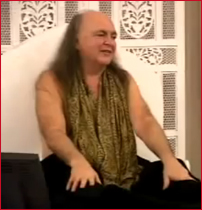 |
Bhagavad Gita — The "Bhagavad Gita" (literally, "Divine Song") is one of the most revered Scriptures of the Hindus, and a religious text of universal appeal and profound esoteric significance.
Bhagavan — The title "Bhagavan" is an ancient one used over the centuries for many Spiritual Realizers of India. It means "blessed" or "holy" in Sanskrit. When applied to a great Spiritual Being, "Bhagavan" is understood to mean "bountiful Lord", or "Great Lord", or "Divine Lord".
bhakta, bhakti — "Bhakti" is the practice of heart-felt devotion to the Ultimate Reality or Person — a practice which has been traditionally animated through worship of Divine Images or surrender to a human Guru.
"Bhakta" is a devotee whose principal characteristic is expressive devotion, or who practices within the Hindu tradition of Bhakti Yoga.
Bhava — "Bhava" is a Sanskrit word used to refer to the enraptured feeling-swoon of Communion with the Divine.
bindu — In the esoteric Yogic traditions of India, the Sanskrit word "bindu" (literally, "drop" or "point") suggests that all manifested forms, energies, and universes are ultimately coalesced or expressed in a point without spatial or temporal dimension. Each level (or plane) of psycho-physical reality is said to have a corresponding bindu, or zero-point.
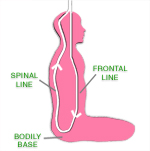 bodily base — The bodily base is the region associated with the muladhara chakra, the lowest energy plexus in the human body-mind, at the base of the spine (or the general region immediately above and including the perineum). In many of the Yogic traditions, the bodily base is regarded as the seat of the latent ascending Spiritual Current, or Kundalini. Avatar Adi Da Reveals that, in fact, the Spirit-Current must first descend to the bodily base through the frontal line, before it can effectively be directed into the ascending spinal course. Avatar Adi Da has also pointed out that human beings who are not yet Spiritually sensitive tend to throw off the natural life-energy at the bodily base, and therefore, He has given His devotees a range of disciplines (including a number of exercises that involve intentional locking at the bodily base) which conserve life-energy by directing it into the spinal line.
bodily battery — The "bodily battery" (known in Japan as the "hara") is the energy center of the physical body and, as such, it plays a very important role in the practice of "conductivity" in the frontal line. Avatar Adi Da describes its focal point (or point of concentration) as the crown of the abdomen, on the surface, about an inch and a half below the umbilical scar.
bond / Bond — Avatar Adi Da uses the term "bond", when lower-cased, to refer to the process by which the egoic individual (already presuming separateness, and, therefore, bondage to the separate self) attaches himself karmically to the world of others and things through the constant search for self-fulfillment. In contrast, when He capitalizes the term "Bond", Avatar Adi Da is making reference to the process of His devotee's devotional "Bonding" to Him, which process is the Great Means for transcending all forms of limited (or karmic) "bonding".
brahmacharinis — Sanskrit: feminine variant of brahmachari: One who moves in Brahman; one who continually fixes the mind on the eternal Truth; a student who practices spiritual discipline and celibacy.
Adi Da used this traditional name for the four young women (who were also his daughters) in the formal Hridaya Da Gurukula Brahmacharini Mandala Order. | | 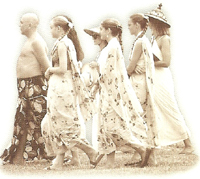 |
Bright — By the word "Bright" (and its variations, such as "Brightness"), Adi Da refers to the Self-Existing and Self-Radiant Divine Reality. As Adi Da writes in His Spiritual Autobiography, The Knee Of Listening: From my earliest experience of life I have Enjoyed a Condition that, as a child, I called the "Bright".
I have always known desire, not merely for extreme pleasures of the senses and the mind, but for the highest Enjoyment of Spiritual Power and Mobility. But I have not been seated in desire, and desire has only been a play that I have grown to understand and enjoy without conflict. I have always been Seated in the "Bright".
Even as a baby I remember only crawling around inquisitively with a boundless Feeling of Joy, Light, and Freedom in the middle of my head that was bathed in Energy moving unobstructed in a Circle, down from above, all the way down, then up, all the way up, and around again, and always Shining from my heart. It was an Expanding Sphere of Joy from the heart. And I was a Radiant Form, the Source of Energy, Love-Bliss, and Light in the midst of a world that is entirely Energy, Love-Bliss, and Light. I was the Power of Reality, a direct Enjoyment and Communication of the One Reality. I was the Heart Itself, Who Lightens the mind and all things. I was the same as every one and every thing, except it became clear that others were apparently unaware of the "Thing" Itself.
Even as a little child I recognized It and Knew It, and my life was not a matter of anything else. That Awareness, that Conscious Enjoyment, that Self-Existing and Self-Radiant Space of Infinitely and inherently Free Being, that Shine of inherent Joy Standing in the heart and Expanding from the heart, is the "Bright". And It is the entire Source of True Humor. It is Reality. It is not separate from anything. |
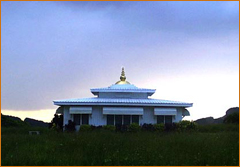 The "Brightness" — The most sacred Place of Adidam, The "Brightness" (or The "Outshining Brightness Temple", or "Atma Nadi Shakti Loka") is the secluded Temple on the island of Naitauba which Avatar Adi Da established in 1993 as His burial place, and which has housed His physical remains since His Divine Mahasamadhi on November 27, 2008. In various sacred traditions, it is said that the body of an Adept-Realizer should not be cremated — that (in the case of an Adept-Realizer) cremation is actually a form of desecration. It is traditionally said that you should put the body in a sacred place, and visit the place, and tend to the Spiritual Master there, in perpetuity — and you should not presume that the Spiritual Master is like an ordinary man, an ego, who needs to be helped in the transition to the next stage of development by the purifying act of fire, the cremation process.
|
It is an Eternal Intention that I Demonstrate and Speak about during My physical Lifetime, a Work to go on forever. I Established a Place of My Radiation. It is the Place where this Body in Its end-time will be fitted. I have Accounted for everything. My Mahasamadhi Site will ultimately become the Principal Locus on the Island. The "Root"-Place, the Source-Point is here, at Adi Da Samrajashram, where people will have the most immediate contact with Me beyond My physical Lifetime. This is the Principal Seat, the Blessing-Seat, the Source-Position — in perpetuity. People are to come to Me, where and As I Am. That is how I will Transform humankind and the Earth-"world".
Avatar Adi Da Samraj, November 20, 1993 |
Buddha — Just as the traditional term "Avatar", when rightly understood, is an appropriate Reference to Avatar Adi Da Samraj, so is the traditional term "Buddha". He is the Divine Buddha, the One Who Is Most Perfectly Self-Enlightened and Eternally Awake.
| chakra — Sanskrit for "wheel". The "chakra body" is the etheric and subtle system of centers that conduct psychic force and nerve-force to and through the principal regions of the body. The chakra body is generally conceived of as having seven principal chakras, at seven physical locations on the central axis of the body, associated, respectively, with the perineum (or bodily base), the genitals, the navel and solar plexus, the heart, the throat, the midbrain (the "ajna chakra"), and the crown of the head. The ajna chakra, or "third eye", is located behind the center of the forehead, above the eyes. | | 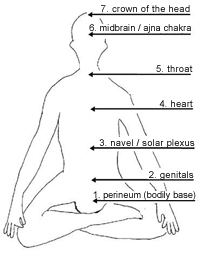 |
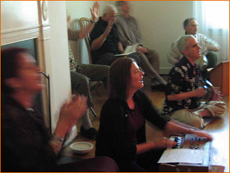
childish and adolescent strategies — Avatar Adi Da uses the terms "childish" and "adolescent" with precise meanings in His Wisdom-Teaching. He points out that human beings are always tending to animate one of two fundamental life-strategies: the childish strategy (to be dependent, weak, seeking to be consoled by parent-figures and a parent-"God") and the adolescent strategy (to be independent — or, otherwise, torn between independence and dependence — rebellious, unfeeling, self-absorbed, and doubting or resisting the idea of God or any power greater than oneself). Until these strategies are understood and transcended, they not only diminish love in ordinary human relations, but they also limit religious and Spiritual growth.
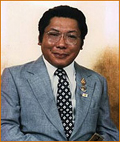
Chögyam Trungpa |
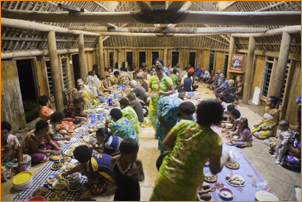
Ciqomi meeting hall |
Ciqomi — Pronounced: thing-GO-mee. The name given by Adi Da in 1983 to the Fijian village at Adi Da Samrajashram. In Fijian, Ciqomi means "Acception" or "Great Reception". Adi Da chose this name in acknowledgement of the Fijian residents' open-hearted acceptance of Him.
 Circle of conductivity — One of the unique aspects of Avatar Adi Da's Revelation of the Way of Adidam is His complete description of the esoteric anatomy of the human being and how this relates to the Spiritual process. Just as the human body has a gross anatomy (of bones, flesh, nerves, and so on), there is also an esoteric anatomy, consisting of three primary structures. The esoteric anatomy of the human body-mind is the basis for all dimensions of human experience — of the ordinary, extraordinary, mystical, and Transcendental kinds.
One of the structures of esoteric anatomy is what Adi Da calls "the Circle of conductivity". The Circle is a pathway through the body composed of two arcs—the descending arc (or "frontal line"), starting at the crown of the head and going downwards to the perineum, and the ascending arc (or "spinal line"), starting at the perineum and going upwards to the crown of the head. The Circle is the primary energy pathway in the body, through which both the natural energy of life and the Divine Spirit–Energy flow. As one becomes more sensitive to the subtle dimensions of experience, one can feel energy moving in the body through the Circle.
The Spiritual Initiation that Adi Da gives to His fully prepared listening devotees is the Infusion of His Divine Spirit–Energy (or Spirit–Current) into the frontal line of the Circle. As one matures in the practice of the Way of Adidam, the Circle becomes more and more tangibly full of Adi Da's Divine Spirit–Current — first in the frontal line, and then also in the spinal line. On certain occasions in the practice of a Spiritually mature devotee, the entire Circle will become utterly full of His Divine Spirit–Current — so open to His Divine Infusion that one ceases to be identified with body or mind in the usual sense, and becomes aware (instead) of existing as a vastly expanded spherical form of the Divine "Brightness". This is the Samadhi of the "Thumbs" — a form of Samadhi uniquely Given by Adi Da. Eventually, the experience of the "Thumbs" becomes constant, such that the presumption of existing as body and mind no longer "rules" one's life. Then one is ready to receive Adi Da's Gift of the Awakening to the Witness–Consciousness, which makes possible the beginning of the "Perfect Practice".
Because there is a "downward–and–upward" quality to the Circle (with its descending and ascending arcs), Adi Da refers to the Circle as the "vertical" dimension of esoteric anatomy (complementing the "horizontal" dimension of the stations of the heart). Most of the world's Spiritual traditions are focused in processes that relate to the Circle — seeking, as an ultimate result, some kind of "ascended" Union with the Divine (found by subtly ascending beyond the body–mind, through and beyond the crown of the head). In the most advanced traditional developments of this "vertical" approach to the Divine, there is, in fact, ascent to the Source–Matrix of Divine Light which is infinitely above. Such ascended Union with the Divine, however, is not permanent (or eternal), because it depends on the effort of the individual — the effort to "go up". Thus, such ascended Union with the Divine is not most perfect Divine Enlightenment. Rather, it involves choosing the "Light" (or "Energy") aspect of the Divine over the "Consciousness" aspect.
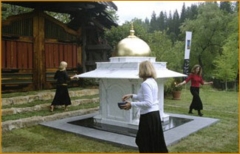 circumambulation puja — A traditional ritual in which a physical area (a building, a holy site, a property, etc.) is blessed as one invokes the Divine while walking around it clockwise (typically three times). The circumambulation is usually accompanied by waving lighted candles and ringing bells, and by tossing water and ash along the perimeter of the circle or property boundary, with the intent of invoking the Divine to bless and protect the property. Sometimes there is a recitation as well. Because of the number of activities, the puja often involves several devotees.
Adi Da often instructed devotees to do such a circumambulation puja around the Adidam Sanctuaries (and occasionally doing such a circumambulation puja Himself).
Other circumbulation pujas are forms of worship — what is being circumambulated (for example, the Paduka Mandir holy site at The Mountain Of Attention) is understood to be Adi Da's Form. (In the case of Paduka Mandir, one circumambulates the holy site before entering it, as a form of preparatory worship.)
Naturally, when one does a "circumambulation" puja around an island like Naitauba, one would use a boat rather than walking — a "circumnavigation" puja. Retreatants visiting Naitauba often do a circumnavigation of the island by boat when they first arrive at the island and when they leave.
Circumambulation pujas can be found in other religious traditions. For example, circumbulatory walking around a shrine is a common form of Hindu prayer. The Buddhist tradition contains rituals for circumbulating stupas, shrines, holy mountains, or even children (almost anything considered special).
See also: puja
| Communion Hall — A place containing a photographic image of Adi Da Samraj that is set aside for meditation and sacramental worship (puja). | | 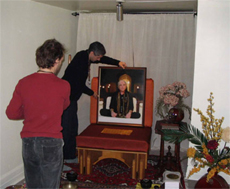
An Adidam Communion Hall in Eastern Canada |
conditional — The word "conditional" (and all its variants: "conditionally", "conditional existence", "conditionality", etc.) is used to indicate everything that depends on conditions — in other words, everything that is temporary and changing. The "Unconditional" (or "Unconditional Existence"), in contrast, is the Divine, or That Which Is Eternal, Always Already the Case — because It Is utterly Free of dependence on any conditions whatsoever.
congregations of Adidam — Avatar Adi Da has created four congregations in order to make it possible for everyone to enter into devotional and Spiritual relationship to Him — both those who are moved to practice the Way of Adidam in the fullest and most profound manner (first and second congregations) and those whose life-circumstance makes it right and appropriate for them to practice a simpler form of the Way of Adidam (third congregation and fourth congregation). For each of the congregations, there are particular qualifications for membership and there is a particular form of practice of the Way of Adidam to be engaged. Which of the four congregations you should apply to for membership depends on the nature of your response to Avatar Adi Da Samraj and on your life-circumstance. Membership in any of the four congregations establishes you in a direct devotional relationship with Avatar Adi Da, and all four congregations are essential to the flowering of His Blessing-Work in the world. - The First Congregation is comprised of individuals who engage the complete, full, and intensive process of the Reality-Way of Adidam, including devotional response to Avatar Adi Da, right practical living, and the practice of "Perfect Knowledge". They are eventually accepted into a Transcendental Spiritual process with Avatar Adi Da that ultimately leads to Divine Self-Realization, by His Grace.
- The Second Congregation is the congregation of devotees who practice devotional response to Avatar Adi Da and practical right life disciplines, as well as rudimentary study of Avatar Adi Da's "Perfect Knowledge" Teachings. Anyone who intends to practice in the First Congregation begins his or her adaptation in the Second Congregation.
- The Third Congregation is made up of people whose commitment to Avatar Adi Da is primarily a simple devotional relationship to Him, together with advocacy and financial support of His Work. The Third Congregation also includes individuals who maintain a traditional religious affiliation.
- The Fourth Congregation is comprised of people from indigenous and/or traditional cultures around the world whose approach to Avatar Adi Da is one of simple devotional relationship to Him.
conscious environment — Part of one's practice as a devotee is to make one's environments (personal and shared) conscious: clean and orderly, in the manner of a "Swiss dairy farm": Make every environment and room in which you live, play, and work an attractive expression of your feeling-Contemplation of Me. The quality of your living environment is always an expression of your own state — and, conversely, the quality of your environment directly affects you whole-bodily, not just physically, but emotionally, psychologically, psychically. So make the spaces in which you live and work pleasing and attractive to the whole body, not just to the sense of visual aesthetics or to the thinking mind. Avatar Adi Da Samraj, The Eating Gorilla Comes In Peace Every square inch of the Ashram should look like a Swiss dairy farm, meaning: in order, clean, bright, showing the signs of conscious control, real discipline, and care. That is to say, every square inch of the Ashram should be treated as an extension of My bodily (human) Form and as a suitable embodiment of My Presence altogether. Avatar Adi Da Samraj |
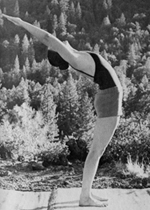 conscious exercise — In the Way of Adidam, the practice of "conscious exercise" integrates the faculties of the body-mind: body, mind, breath, and feeling. Through the yoga of devotion to Avatar Adi Da, "conscious exercise" sensitizes one to, and enables one to conduct the universal life-energy that pervades and animates the psycho-physical being. Additionally the exercises magnify the unobstructed flow of energy (both natural bodily energy and Spiritual Energy) in the body. As Adi Da describes in the essay, "Conscious Exercise Is Mature (or Truly Human) Activity" in The Aletheon: "The principal (or basic) physical regimens of 'conscious exercise' I have Given (for all of which regimens I have Given fully elaborated Descriptions in Conscious Exercise and The Transcendental Sun) are Da Namaskar, Da Fours, Da Chi Gong, a recommended sequence of Hatha Yoga poses (and breathing exercises), a recommended sequence of calisthenics (engaged in a vigorous manner, but not to the point of excessive hyperventilation), and principles of ordinary bodily posture and movement (including conscious walking, standing, and sitting, as well as postures that support right 'conductivity' practice and right physical balance in repose)."
consideration, reality consideration — Avatar Adi Da uses this phrase to refer to "a process of one-pointed (but ultimately thoughtless) concentration and exhaustive contemplation of a particular object, function, person, process, or condition, until the essence or ultimate obviousness of that object is clear" [p. 1, Love of the Two-Armed Form]. Such a process was originally described by Patanjali, in his Yoga Sutras, as "samyama" (Sanskrit: "holding together, tying up, integration"). The word "consideration" in our Way has a technical and special meaning. It literally means to inspect the stars, from "Sidus", meaning "Star". "Con" means "with" or "together". You could speculate that to "consider" originally meant "to bring two stars together", or, in other words, to realize the non-contradiction in two opposing sides of a problem. Consideration, then, is the process of giving yourself completely to some force, problem, or subject, entering into a completely, with full concentration, full seriousness, even whole-bodily or psycho-physically to the fullest extent, intensively, entering into it with such concentration, such fullness, that it becomes a kind of contemplation until the contradiction in it or the problem is resolved in a Singleness, a perception that is free and in which the nature of that which you contemplate has become obvious, the Truth of it is revealed.
Avatar Adi Da Samraj
Crazy Wisdom Magazine, Vol. 6 #3 |
The Way of Adidam is a reality consideration, not a religious "belief system". This is true both in the way it was developed by Adi Da, and in the way it is practiced by devotees. I Brought My Divine Wisdom-Teaching out of My Self—through My Avataric Self-Submission to the Great Process of "reality consideration" with My devotees and with the world altogether. I am not here merely reading books and passing on an old tradition to people. Nor am I here to believe and to support the illusions of humankind. The only-by-Me Revealed and Given Way of Adidam, in Its entirety and in Its every aspect, has been Brought out of Me. The Way of Adidam has Appeared only through the Avataric Divine Process of My own Lifelong "reality consideration". The Way of Adidam is the Divine Process of My Own Avataric Self-Submission to conditional reality—Which Avataric Self-Submission Started at the moment of My Avataric Human Birth (and Which Avataric Self-Submission Continues—now, and forever hereafter)."
|
| Cosmic Mandala — The Sanskrit word "mandala" (literally, "circle") is commonly used in the esoteric Spiritual traditions of the East to describe the hierarchical levels of cosmic existence. Adi Da uses the phrase "Cosmic Mandala" as a reference to the totality of the conditionally manifested cosmos (all worlds, forms, and beings), which (He has revealed) can be visually perceived as a pattern of concentric circular bands (or, more accurately, spheres) of certain distinct colors (each of a particular relative width), with a Brilliant White Five-Pointed Star at the center. | |  |
Crashing Down — "Crashing Down" is a description Avatar Adi Da has given for the Descent of His Divine Spirit-Force "From The 'Place' Infinitely Above the body-mind and the world, Down and Most Deeply Into the body-mind and the world — Even To The Degree That the ego-'I', or self-Contraction, Is Utterly Confounded, Utterly Yielded, and Utterly Vanished In My Avatarically Self-Revealed, and Self-Evidently Divine, Person, or Self-Condition, Which Is Real God, and Truth, and Reality" [The Dawn Horse Testament].
Crazy / Crazy Wisdom — Avatar Adi Da has always had a unique Method of "Crazy" Work, which, particularly during His years of Teaching and Revelation, involved His literal Submission to the limited conditions of humankind, in order to reflect His devotees to themselves, and thereby Awaken self-understanding in them (relative to their individual egoic dramas, and the collective egoic dramas of human society).
For Me, There Was Never Any Other Possibility Than The "Reckless" (or Divinely "Crazy" and Divinely "Heroic") Course Of All-and-all-Embrace — and I Began This Uniquely "Crazy" and "Heroic" Sadhana, Most Intensively, At The Beginning Of My Adult Life.
Indeed, I Have Always Functioned, and Will Always Function, In This Divinely "Crazy" and Divinely "Heroic" Manner. The Inherently egoless "Crazy" and "Heroic" Manner Is One Of My Principal Divine Characteristics — Whereby I Can (Always, and Now, and Forever Hereafter) Be Identified.
Therefore, I (Characteristically) Functioned In This "Crazy" and "Heroic" Manner Throughout All Of My "Sadhana Years", and Throughout All The Years Of My Avatarically Self-Manifested Divine Teaching-Work and My Avatarically Self-Manifested Divine Revelation-Work — and I Have Done So (and Will Forever Continue To Do So) Throughout All The Divine-Self-"Emergence" Years Of My Avatarically Self-Manifested Divine Blessing-Work (Both During, and Forever After, My Avataric Physical Human Lifetime).
All My Avatarically Self-Manifested Divine Work Is A Divinely "Crazy" and Divinely "Heroic" Effort That Avoids Not anything or any one — but Which Always Divinely Blesses Everything and Everyone.
|
For more, visit our Crazy Wisdom section. Crazy Wisdom Fellowship — The name Adi Da gave to the culture of devotees, during the early 1980's. | Crazy Wisdom magazine — A magazine published by The Dawn Horse Press in the 1980's (February, 1982 - February, 1989). | 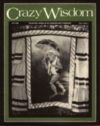 |

Sanskrit
"Da" symbol |
Da — Avatar Adi Da's Name "Da" means "The Divine Giver". In Sanskrit, "Da" means principally "to give". It is also associated with Vishnu, the "Sustainer", and it has a secondary meaning "to destroy". Thus, "Da" is anciently aligned to all three of the principal Divine Beings, Forces, or Attributes in the Hindu tradition — Brahma (the Creator, Generator, or Giver), Vishnu (the Sustainer), and Siva (the Destroyer). In certain Hindu rituals, priests address the Divine directly as "Da", invoking qualities such as generosity and compassion.
The Tibetan Buddhists regard the syllable "Da" (written, in Tibetan, as well as in Sanskrit, with a single symbol) as most auspicious, and they assign numerous sacred meanings to it, including that of "the Entrance into the Dharma".
Da Avatar — "Da" is Sanskrit for "The Divine Giver". Therefore, as the Da Avatar, Adi Da Samraj is the Divine Descent of the One and True Divine Giver.
 | | Da Love-Ananda Mahal — The Ruchira Sannyasin Sanctuary established by Adi Da Samraj in Hawaii. (One of its previous names was Tumomama.) More can be found here. |
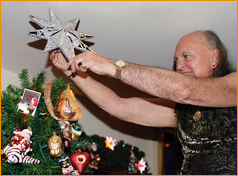
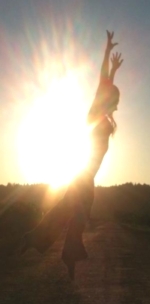 | | dancing down the Light — Adi Da's phrase for deliberate, ecstatic dancing (often communal) to upbeat music while contemplating Him as the Divine, invoking Him, and conducting Him down into the body.
Like Sufi dervishes who raise one arm to the sky to receive God's grace and point the other arm down to the earth as a symbol of giving that grace to the human world, dance for Grace. Like the gopis in their dance around Krishna, dance the lovely circle of human love made Divine and Divine love for humankind. Like the Paiutes in their Spirit Dance, dance as a community, dance together that all people may live in peace.
Dance down the Light.
Spiritual life is an own-body Yoga, unobstructed participation in All and everything. And the entire body-mind must be Liberated from all contraction. All dependencies, you see, all conditionality. And that Free Disposition must become the basis for participation in the conditions of human existence. Positive participation, transformative participation, participation that is constant Divine Invocation. So this is what Dancing Down My Light is about, you see? If you're too tight-assed to dance, you can't Invoke Me, you see? It's not a talking school. It's a dancing school. Avatar Adi Da Samraj |
|
| Darshan — A Sanskrit word referring to the sacred devotional sighting of the Guru, or of images of the Divine. | | 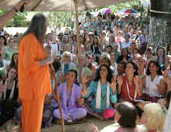
Devotees receiving Adi Da's Darshan at The Mountain Of Attention |
Dau Loloma — Fijian name given to Adi Da by the Fijian residents of Adi Da Samrajashram. It means "the Adept of Love" and is an acknowledgement of their recognition of Him.
 Dawn Horse — In 1970, Avatar Adi Da experienced a waking Vision. He found Himself in a subtle realm, observing a Spiritual Master demonstrating to his disciples the Yogic power of manifesting objects spontaneously. Avatar Adi Da watched as the Master began the process of manifestation. After a time, although nothing had yet materialized, the Master's disciples departed, apparently satisfied that the work was done. Avatar Adi Da was left alone, standing before the Master. Then gradually a vaporous shape arose before His eyes. As it became more clearly defined, He saw that it was a perfectly formed, living and breathing horse, perhaps three feet high. Later, when He saw a documentary on "eohippus" (meaning "dawn horse" in Greek), the smaller ancestor of today's horse, He decided to name the horse of His Vision the "Dawn Horse".
In 1984, Avatar Adi Da spoke about His Vision:
I was at once the Adept who performed the miracle of manifesting the horse, and I was the one who was party to the observation of it and its result. And I did not have any feeling of being different from the horse itself. I was making the horse, I was observing the horse, and I was being the horse.
Avatar Adi Da has explained that this Vision was a sign of the future manifestation of His own Work in the world. The Dawn Horse was also a sign of Avatar Adi Da's own Person, taking form in and as the conditional universe. And so the Dawn Horse became a symbol for His Life and Work, and for the Coinciding of the Divine Reality and the conditional worlds.
For more about the Dawn Horse, click here. See also: The Dawn Horse Testament; The Dawn Horse Press.
devotional group — Earlier name: "reality group". Practitioners of the Way of Adidam are aided in their practice by belonging to a devotional group. A devotional group is a key element of the culture of Adidam. Its primary purposes are to provide occasions for collective devotional invocation of Adi Da, and to help each other grow in ego-transcending practice. Through time and intimacy, members of a devotional group get to know each other well, and therefore, get to know each other's egoic patterning as well. Group members are thus in a unique position to serve each other's practice, by seeing things a particular member might not see about himself or herself, by helping members take on disciplines that cut into their particular egoic patterns, and by helping members stay accountable for fulfilling and persisting in the counter-egoic disciplines they take on. Such reflection and disciplining of egoic patterning is essential for growth in practice of the ego-transcending Way of Adidam. For more about devotional groups, read our article, The Artfulness of Helping Each Other Take Up (and Persist in) Disciplines, and listen to Adi Da's talk about the primary function of devotional groups, When the Tiger Disappears.
Devotional Prayer of Changes — A practice given by Adi Da Samraj of prayerful Communion with Him for the sake of positive change in life-circumstances and the world. Your responsibility does not depend on your "creature"-power or ego-power. It depends on your participation in Me, and on your engaging in the practices that establish your own mechanism as the means for the very same things you are presently calling on Me to Do by what may look to you to be My Personal Intention.
This is another characteristic of My Sign and My Demonstration of My Divine Indifference. I have Shown you how to do everything. Now your Devotional Prayer of Changes becomes effective because you use My Virtue, through your practice of whole bodily devotional turning to Me, and through your taking your responsibilities seriously rather than imagining that they are only mysterious obligations that have nothing to do with you. You are drawing on My Virtue simply by practicing the Devotional Prayer of Changes, or true whole bodily devotional turning to Me. You allow your own mechanism to become the means.
My devotees are to provide the body-minds whereby My Virtue becomes Effective. If you will really do so, then changes will occur. Yes, they will be changes that I have Made, but in the fashion I have just Described to you.
So it will be forever. That My devotees have received the Secret of whole bodily devotional turning to Me allows My Divine Translation. It allows Me to be Effective forever throughout the cosmic domain. My Virtue Changes things and Enlightens beings, and It Works, because My devotees assume their responsibilities by embracing the practices I have Given them, doing those practices for real, and using My Virtue.
When the time comes that This Body dies, I will not disappear. I will be wholly Available to you. I will be Effective forever — Fully Conscious, Self-Radiant, never gone, never separate.
In devotional Communion with Me, you associate with, participate in, and draw upon My Own Virtue. That is the Secret of devotional Communion with Me. It has always been the case, but you did not know the Secret. I have Come to Reveal That Secret and to Establish the Fullest Instruction. By your devotional recognition-response to Me, you give Me the Mechanism to Do the same kind of Work I have been Doing in My bodily (human) Lifetime here. I will be Incarnated countlessly by Means of this Process.
Avatar Adi Da Samraj "I Will Be Incarnated Countlessly Through My Devotees", Ishta |
In the Prayer of Changes you purge yourself of false views, negative views, presumptions, and feelings, and intentionally, through whole-bodily submission, enter into a higher presumption, a perfect presumption, the presumption of change from what appears. That new presumption influences the universal field of mind that is controlling phenomena.
A very powerful individual can make great changes, and so also can a gathering of people in a right disposition. True devotees, for instance, will be very effective, more effective than a single individual of minimal spiritual development. This is another reason why it is so important for the community of devotees to grow in size and for the individuals within it to cooperate intentionally with one another relative to changes of all kinds, including the will to Enlightenment for all. That is fundamentally what the Prayer of Changes is about, but it does not mean that lesser positive changes that are secondary to the ultimate matter of Enlightenment are disregarded or considered negative.
The world of changes is very important to spiritual life, it is simply not the principle of spiritual life. Spiritual life is to be incarnated in the realm of changes, because it is in the realm of changes that you are tested, that you go beyond yourself. . . In this prayer, you submit to the Source, which is full of Bliss and Happiness, and provide room for Its Power to change and to fulfill existence.
Avatar Adi Da Samraj |
Adi Da contrasts the Devotional Prayer of Changes - which is based on present-time Communion with the Divine (and the Virtue that flows from that) with conventional prayer - which is based on separation from the Divine and the presumption that the Divine is a Great Other whom one can approach like a parent for favors and blessings.
Devotional Way of Insight / Devotional Way of Faith — For a period of years, Avatar Adi Da gave Instruction on two forms of the fundamental practice of feeling-Contemplation of Him: the Devotional Way of Insight and the Devotional Way of Faith. Each of Avatar Adi Da's fully practicing devotees was to experiment with both of these Devotional Ways and then choose the one that is most effective in his or her case. Both Devotional Ways require the exercise of insight and faith, but there was a difference in emphasis.
In the Devotional Way of Insight, the practitioner engages a specific technical process of observing, understanding, and then feeling beyond the self-contraction, as the principal technical element of his or her practice of feeling-Contemplation of Avatar Adi Da.
In the Devotional Way of Faith, the practitioner engages a specific technical process of magnifying his or her heart-Attraction to Avatar Adi Da, as the principal technical element of his or her practice of feeling-Contemplation of Avatar Adi Da. Avatar Adi Da's extended Instruction relative to both Devotional Ways was given in The Only Complete Way To Realize The Unbroken Light Of Real God. In September, 2006, Adi Da instructed devotees that practice of these two Devotional Ways is no longer to be engaged, because they were associated with His "Submission Years" (or "Teaching Years") work with us.
Dharma — Sanskrit for "duty", "virtue", "law". By extension, "Dharma" means a truly great Spiritual Teaching, including its disciplines and practices.
| didgeridoo — A very long wind instrument, developed by the indigenous people of northern Australia at least 1,500 years ago. (Generally, the longer the instrument, the lower the pitch or key of the instrument.) The didgeridoo is still in widespread usage today both in Australia and around the world, and is used occasionally in the music of Adidam. | | 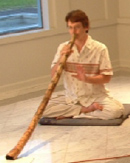 |
difference — "Difference" is the epitome of the egoic presumption of separateness—in contrast with the Realization of Oneness, or Non-"Difference", Which is Native to the Divine Self-Condition.
disciplines — The most basic functional, practical, and relational disciplines of the Way of Adidam (in its fully practiced form, as embraced by devotees in the first and second congregations) are forms of appropriate human action and responsibility (Adi Da calls it "right life") for diet, health, exercise, sexuality, work, service to and support of Avatar Adi Da's Circumstance and Work, and cooperative (formal community) association with other practitioners of the Way of Adidam. The most basic cultural obligations of the Way of Adidam (in its fully practiced form) include meditation, sacramental worship, study of Avatar Adi Da's Wisdom-Teaching (and also at least a basic discriminative study of the Great Tradition of religion and Spirituality that is the Wisdom-inheritance of humankind), and regular participation in the "form" (or schedule) of daily, weekly, monthly, and annual devotional activities and retreats. For more on disciplines in the Way of Adidam, click here.
Divine Being — Avatar Adi Da describes His Divine Being on three levels: This flesh body, this bodily (human) Sign, is My Form, in the sense that it is My Murti, or a kind of Reflection (or Representation) of Me. It is, therefore, a Means for contacting My Spiritual Presence, and, ultimately, My Divine State.
My Spiritual Presence is Self-Existing and Self-Radiant. It Functions in time and space, and It is also Prior to all time and space. . . .
My Divine State is always and only utterly Prior to time and space. Therefore, I, As I Am (Ultimately), have no "Function" in time and space. There is no time and space in My Divine State. |
Divine Body — Avatar Adi Da's Divine Body is not conditional or limited to His physical Body but is "The 'Bright' Itself (Spiritually Pervading and Eternally Most Prior To The Cosmic Domain)".
Divine Emergence — More formally: Avataric Divine Self-"Emergence". On January 11, 1986, Adi Da passed through a profound Yogic Swoon, Which He later described as the Yogic Establishment of His Avataric Divine Self-"Emergence". Adi Da's Avataric Divine Self-"Emergence" is an ongoing Process, initiated at His Birth, in which His Avatarically-Born bodily (human) Divine Form was ever more profoundly conformed to Himself, the Very Divine Person, to the point where His bodily (human) Form (even now, after His human lifetime) is forever hereafter an utterly Unobstructed Sign and Agent of His own Divine Being. That conformation of His own bodily (human) Form was only the initiation of His Divine Emergence. The Divine Emergence continues through devotees practicing the Way of Adidam, and by that means, Invoking, Communing with, and ultimately Realizing the Divine. For Avatar Adi Da's extended description of His Avataric Divine Self-"Emergence", see: You can also read more in our presentation on The Holy Day of the Divine Avataric Self-"Emergence".
Divine Enlightenment — The Realization of the seventh stage of life, which is uniquely Revealed and Given by Avatar Adi Da. It is release from all the egoic limitations of the first six stages of life. Remarkably, the seventh stage Awakening, which is Avatar Adi Da's Gift to His rightly prepared devotee, is not an experience at all. The true Nature of everything is simply obvious, based on the Realization that every apparent "thing" is Eternally, Perfectly the same as Reality, Consciousness, Happiness, Truth, or Real God. And that Realization is the Supreme Love-Bliss of Avatar Adi Da's Divine Self-Condition.
Divine Ignorance — "Divine Ignorance" (also known as "Perfect Ignorance" or "Perfect Knowledge") is Avatar Adi Da's term for the fundamental Awareness of Existence Itself, Prior to all sense of separation from (or knowledge about) anything that arises. As He proposes, "No matter what arises, you do not know what a single thing is." By "Ignorance", Avatar Adi Da means heart-felt participation in the universal Condition of inherent Mystery — not mental dullness or the fear-based wonder or awe felt by the subjective ego in relation to unknown objects. Divine Ignorance is the Realization of Consciousness Itself, transcending all knowledge and all experience of the self-contracted ego-"I".
For Adi Da's most recent Instruction relative to Divine Ignorance, read "Perfect Ignorance", the Prologue to The Aletheon. For more, see What, Where, When, How, Why, and Who To Remember To Be Happy, Part Two: "What, Where, When, How, Why and Who To Remember To Be Happy", and Part Three: "You Do Not Know What even a single thing Is" and "My Argument Relative to Divine Ignorance". You can also watch this video. "Perfect Knowledge" (Which Is Perfect Ignorance) Is Perfect Philosophy—or the Only Right and True Basis for all right and true understanding of "self", "world", "other", all-of-"not-self", and "What" Is Divine.
Avatar Adi Da Samraj, "Perfect Ignorance" |
Divine Intoxication — Unlike common intoxication, such as with alcohol, Divine "Intoxication" Draws Avatar Adi Da's devotees beyond the usual egoic self and egoic mind through His Blessing Grace into a state of ecstatic devotional Communion (and Identification) with Him.
Divine Parama-Guru — The Supreme Divine Guru.
Divine Self-Nature, Divine Self-Condition, and Divine Self-State — In His latter writings, Adi Da often uses these three phrases to signify the primary aspects of the Divine Reality, as in the following passage: | You must consent — with every particle of the body mind-complex, to be Identified with the Divine Self-Nature, Self-Condition, and Self-State of Reality Itself. Then all contraction ceases, is overcome and replaced with Non-Dual Self-Existing Self-Radiance, or Love-Bliss Itself, Being Itself, Consciousness Itself, Light Itself, Energy Itself, Reality Itself. Reality Itself Is the Only God There Is. |
This parallels the use (in Hindu philosophy) of the phrase, Sat-Chit-Ananda, to reflect the three primary aspects of the Ultimate Reality: Sat (Sanskrit: "Truth"), Chit (Sanskrit: "Consciousness"), and Ananda (Sanskrit: "Bliss"). Adi Da has extensively commented on Sat-Chit-Ananda, and has given His Own Enlightened (and updated) rendering of these words: | So the jnani, when he's talking about the Self, the Heart, is talking about realization of one of these principles, the principle of existence: Sat. And the saint, when he's talking about God or the Light is talking about gnosis or intuitive knowledge of the Light which is the second Principle, Chit. And that second Principle is dependent on the first (which is "Sat"). The second principle is "Chit" or Light or Mind. It is sometimes translated as "consciousness" but that is not a proper translation. |
The correlation of this newly rendered Sat-Chit-Ananda with Adi Da's Own terminology is: - Divine Self-Nature: Sat — Consciousness
- Divine Self-Condition: Chit — Light
- Divine Self-State — Ananda — Love-Bliss
Adi Da also uses these phrases separately, to emphasize a particular aspect of Divine Reality. For example, the following passage from His "Gorilla Sermon", which is about Divine Enlightement as "Awakening", not surprisingly emphasizes the "Consciousness" ("Divine Self-Nature") aspect: Those who are Awakening in Truth begin to notice something. They begin to recognize the signs. They begin to recognize the activity of dreaming. They begin to sense something very unusual about Me.
I Am your own True Self-Nature Appearing within the dream to Awaken you. I Am your Awakening, and your Always Already Conscious State. |
Divine Self-Recognition — Divine Self-Recognition is the ego-transcending and world-transcending Intelligence of the Divine Self in relation to all conditional phenomena. The devotee of Avatar Adi Da who Realizes the seventh stage of life simply Abides as Self-Existing and Self-Radiant Consciousness Itself, and he or she Freely Self-Recognizes (or inherently and instantly and Most Perfectly comprehends and perceives) all phenomena (including body, mind, conditional self, and conditional world) as transparent (or merely apparent), and un-necessary, and inherently non-binding modifications of the same "Bright" Divine Self-Consciousness.
Divine Star — The primal conditional Representation of the "Bright" (the Source-Energy, or Divine Light, of Which all conditional phenomena and the total cosmos are modifications) is the brilliant white five-pointed Divine Star. Avatar Adi Da's bodily (human) Divine Form is the Manifestation of that Divine Star — and His head, two arms, and two legs correspond to its five points. Avatar Adi Da can also be seen or intuited in vision to Be the Divine Star Itself, prior to the visible manifestation of His bodily (human) Form.
Divine Translation — The ultimate stage in the four stages of the seventh stage of life, which Avatar Adi Da describes as the "Outshining of the cosmic domain". In the case of any other being, Divine Translation necessarily coincides with physical death; but in Avatar Adi Da's unique case, He remained bodily active and alive for eight and a half years after He entered the Divine Translation phase of the seventh stage of life on April 12, 2000.
Divine World-Teacher — Avatar Adi Da Samraj is the Divine World-Teacher because His Wisdom-Teaching is uniquely Perfect Instruction for every being — in this (and every) world — in the total process of Divine Enlightenment. Furthermore, Avatar Adi Da Samraj constantly extends His Regard to the entire world (and the entire Cosmic domain) — not on the political or social level, but as a Spiritual matter, constantly working to Bless and purify all beings everywhere.
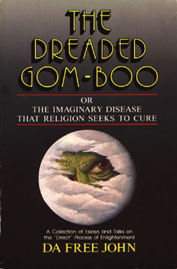 Dreaded Gom-Boo — The title of a 1983 book by Adi Da. The subtitle is "The Imaginary Disease That Religion Seeks to Cure", and the core theme is similar to that of His earlier book, No Remedy. Adi Da uses the phrase, "Dreaded Gom-Boo", to caricature the notion many religions communicate that there is something wrong with a human being ("original sin", "desire", "suffering", etc.), that is in need of a cure. That message sets one on a search to remedy the problem, or to take up the specific cure offered by the religion. Adi Da offers a different communication: perfect truth, freedom, and happiness is always already the case. It is the search itself (and egoity itself) that must be transcended, and the perfect transcendence of egoity coincides with the Realization of perfect truth, freedom, and happiness.
| Drukpa Kunley (1455-1570) — A great Tibetan Master of Mahamudra, a form of Buddhism. Known as a "crazy wisdom" Master, he is the subject of many Tibetan folk stories due to his unconventional behavior and manner of teaching. During Avatar Adi Da's "Teaching Years" He recommended Drukpa Kunley as one of the traditional Masters for devotees to study, in order to better understand His own Work and Manner. For more read the biography, Divine Madman: The Sublime Life and Songs of Drukpa Kunley, translated by Keith Dowman. | | 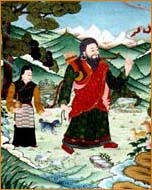
the Crazy Wise master
Drukpa Kunley |
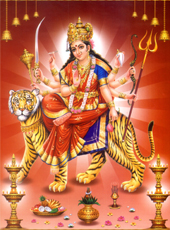 | | Durga — While living at Swami Muktananda's Ashram in early 1970, Adi Da experienced the direct intervention of the Goddess-Power, or Shakti, Who revealed Herself to be a Divine Personality present to guide the final stages of His Sadhana. One of the forms in which she appeared to Him at that time (and later in His life) was the Hindu goddess, Durga. This form of the Goddess has always held a special significance for Adi Da, and He has established a number of statues and Empowered shrines of Durga in the Sanctuaries of Adidam. |
ego-I — The ego-"I" is the fundamental activity of self-contraction, or the presumption of separate and separative existence.
Eleutherian Pan-Communion of Adidam — The Eleutherian Pan-Communion of Adidam is a California religious non-profit corporation, dedicated to the worldwide practice and the global proclamation of the true world-religion of Adidam.
Eleutherios — "Eleutherios" (Greek for "Liberator") is a title by which Zeus was venerated as the supreme deity in the Spiritual esotericism of ancient Greece. In Adidam, the designation "Eleutherios" indicates the Divine Function of Avatar Adi Da as the Incarnation of the Divine Person, "Whose Inherently Perfect Self-'Brightness' Divinely Liberates all conditionally Manifested beings — Freely, Liberally, Gracefully, and Without Ceasing — now, and forever hereafter".
epoch — When Adi Da uses this word He generally is referring to another cycle of the universe, from the "big bang" beginning of space-time to the end of space-time — in short, an immense period of time before another such "opening" is likely to be available again.
esoteric anatomy — One of the unique aspects of Adi Da's Revelation of the Way of Adidam is His complete description of the esoteric anatomy of the Spiritual process. Just as the human body has a gross anatomy (of bones, flesh, nerves, and so on), there is also an esoteric anatomy. Understanding this esoteric anatomy is a key to understanding what makes the Way of Adidam uniquely complete, and why the Divine Enlightenment that Adi Da offers is an unprecedented Gift.
In Adi Da's Revelation, human esoteric anatomy has three structures: - the Circle of conductivity is a pathway through the body composed of two arcs: the descending arc (or "frontal line"), starting at the crown of the head and going downwards to the perineum, and the ascending arc (or "spinal line"), starting at the perineum and going upwards to the crown of the head. The Circle is the primary energy–pathway in the body, through which both the natural energy of life and the Divine Spirit–Energy flow.
- the three stations of the heart — The "left side" corresponds to the physical heart and the gross dimension of the being. The "middle station" corresponds to the "heart chakra" and the subtle dimension of the being. The "right side" is the "seat" of the causal dimension (or root–dimension) of the being.
- Amrita Nadi is a radiant energy structure, the "Bright" Itself as It Manifests in the context of the human body–mind. Amrita Nadi is shaped like the letter "S", extending from the right side of the heart (as its "lower terminal") through the chest, throat, and head, and then to the Source–Matrix of Divine Light infinitely above (as its "upper terminal").
For more, see Circle of conductivity; stations of the heart; and Amrita Nadi.
etheric — The etheric is the dimension of life-energy, which functions through the human nervous system. Our bodies are surrounded and infused by this personal life-energy, which we feel as the play of emotions and life-force in the body.
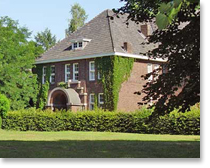
The European Danda | | European Danda — Adidam's primary Ashram and Retreat Centre in Europe. Located in Maria Hoop, near Roermond, Holland. Offers retreats for practitioners of the Way of Adidam, and for the public. Public retreats are offered in Spring, Summer and Autumn, with participants from all over Europe. For more, click here. |
faculties, four faculties — Avatar Adi Da has Instructed His devotees that the practice of devotional Communion with Him (or Ruchira Avatara Bhakti Yoga) requires the turning of the four principal faculties of the human body-mind to Him in every moment. These faculties are body, emotion (or feeling), mind (or attention), and breath.
Feeling of Being — The Feeling of Being is the uncaused (or Self-Existing), Self-Radiant, and unqualified feeling-intuition of the Transcendental, Inherently Spiritual, and Self-Evidently Divine Self-Condition. This absolute Feeling does not merely accompany or express the Realization of the Heart Itself, but It is Identical to that Realization. To feel — or, really, to Be — the Feeling of Being is to enjoy the Love-Bliss of Absolute Consciousness, Which, when Most Perfectly Realized, cannot be prevented or even diminished either by the events of life or by death.
feeling of relatedness — In the foundation stages of practice in the Way of Adidam, the basic (or gross) manifestation of the avoidance of relationship is understood and released when Avatar Adi Da's devotee hears Him (or comes to the point of most fundamental self-understanding), thereby regaining the free capability for simple relatedness, or living on the basis of the feeling of relatedness rather than the avoidance of relationship. Nevertheless, the feeling of relatedness is not Ultimate Realization, because it is still founded in the presumption of a "difference" between "I" and "other". Only in the ultimate stages of life in the Way of Adidam is the feeling of relatedness itself fully understood as the root-act of attention and, ultimately, transcended in the Feeling of Being.
feeling-Contemplation — Avatar Adi Da's term for the essential devotional and meditative practice that all practitioners of the Way of Adidam engage at all times in relationship to Him. Feeling-Contemplation of Adi Da Samraj is Awakened by His Grace — through Darshan (or feeling-sighting) of His bodily (human) Form, His Spiritual Presence, and His Divine State. It is then to be practiced under all conditions, as the basis and epitome of all other practices in the Way of Adidam.
 Findhorn garden — In 1962, Peter and Eileen Caddy and Dorothy Maclean started a vegetable garden in Forres, Scotland. Dorothy discovered she was able to intuitively contact the spirits of plants (devas) who gave her instructions on how to make the most of their fledgling garden. Peter translated this guidance into action, with amazing results. From the barren sandy soil of the Findhorn Bay Caravan Park grew huge plants, herbs and flowers of dozens of kinds, most famously the now-legendary 40-pound cabbages. Word spread, horticultural experts came and were stunned, and the garden at Findhorn became famous.
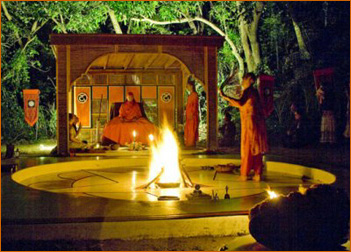 Fire Puja — A puja is a ceremonial form of devotional attention, or worship and invocation. A fire puja is a particular form of puja that uses the elemental force and display of fire to hold attention. In Adidam, a fire puja serves as a means for contemplating Adi Da (as the fire), and as a means for carrying out purification of various kinds.
Fire pujas can be used for specific purposes. Here are a few examples: Each year's celebration of the Divine Avataric Self-"Emergence" culminates in a fire puja, in which a wooden horse is offered to the fire. Each year, a prosperity puja is held at The Mountain Of Attention Sanctuary. Devotees from around the world send intentions which are printed on paper and burnt in the fire. A perpetual fire puja has been performed at Aham Da Ligni Sthan at Adi Da Samrajashram,ever since Adi Da's Divine Mahasamadhi, for the sake of the world and all beings at this critical time in world history.
Fire pujas can be performed anywhere, even inside a devotee's house (for example, using a fireplace). However, special locations are also often set aside for exclusively performing fire pujas. For example, each of the Empowered Sanctuaries has special holy sites that are set aside for performing fire pujas, for example: Agni Lingi Sthan at Adi Da Samrajashram; Red Sitting Man at The Mountain Of Attention; and Fire Keeper at Da Love-Ananda Mahal. ( Click here to watch a video clip of a fire puja at Da Love-Ananda Mahal.) See also: puja.
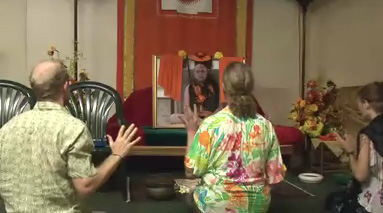
Devotees offering the First Great Invocation |
First Great Invocation — The First Great Invocation and the Second Great Invocation are used to formally begin and end almost every kind of cultural event in Adidam, including daily Sat-Guru Pujas, meetings, and devotional groups. In general, everyone turns to a picture or Murti of Adi Da, and raises their hands, as they engage in the Invocation. The First Great Invocation leader (often ringing a singing bowl):
Now let us offer the First Great Invocation. all participants: Divine Heart-Master Adi Da Samraj, All-Pervading Giver Of Spirit-Life, Consciousness where I appear and disappear, Hear my breathing heart. Awaken me now, By Your Sudden Grace, To Find You here, Before me, and All-"Bright", Dissolving this mind and body in Your Heart. I Hold Up my hands. ( All bow to Adi Da.)
five sheaths — In various Hindu traditions, the human body-mind-self is comprised of a number of "sheaths" or "koshas" (the Sanskrit term). The number and nature of these sheaths varies with the tradition. Adi Da confirms one of these traditional views — one with five sheaths — and outlines the correspondence between the three bodies (gross, subtle, and causal) and the five sheaths: In My "Consideration" of the stages of life, I make use of the traditional descriptions of the sheaths, but I find the description of five sheaths to be the most accurate and complete: - The gross body (or the physical body) is annamayakosha (the "food-sheath", or the "food-body").
- The subtle body — or the internal personality (or group of functions) — is made of three functional parts. The first (which may be contacted inwardly, but which is really surrounding the gross body) is pranamayakosha (the "pranic sheath", or the "pranic body", or the "body of personal life-energy"). The second is manomayakosha (or the "sheath of lower mind"). The lower mind (or the mind of thoughts themselves) includes the conscious mind, the subconscious mind, and the unconscious mind — and the functional activity of the lower mind (or brain-mind) is generated from a position that stands above (and is senior to) the pranic body. The third (and most senior) part of the subtle body is vijnanamayakosha (the "sheath of higher mind", the "sheath of superconscious mind", or the "sheath of intellect"). At the core of the higher mind is the central will and discriminative (and naturally observant) intelligence of the conditional "I" (or limited "self") — and the functional activity of the higher mind is generated from a position that stands above (and is central, and senior, to) the sheath of lower mind.
- Finally, there is anandamayakosha (the "sheath of conditional bliss", or the "causal body"), which is the "causative root" of conditional "selfhood". The true causal body is associated with the right side of the bodily apparent heart (which is, itself, the Ultimate Passageway to Transcendental Self-Consciousness).
|
forms of practice in the Way of Adidam — Avatar Adi Da has Given a number of different approaches to the progressive process of Most Perfectly self-transcending Real-God-Realization in the Way of Adidam. In this manner, He accounts for the differences in individuals' qualities — particularly relative to their capability to make use of the various technical practices that support the fundamental practice of Ruchira Avatara Bhakti Yoga and relative to the intensity of their motivation to apply themselves to the Spiritual process in His Company.
Ruchira Avatar Adi Da refers to the most detailed development of the practice of the Way of Adidam as the "technically 'fully elaborated'" form of practice. Each successive stage of practice in the technically "fully elaborated" form of the Way of Adidam is defined by progressively more detailed responsibilities, disciplines, and practices that are assumed in order to take responsibility for the signs of growing maturity in the process of Divine Awakening. A devotee who embraces the technically "fully elaborated" form of practice of the Way of Adidam must (necessarily) be a member of the first or second congregation of Avatar Adi Da's devotees. The progress of practice in the technically "fully elaborated" form of the Way of Adidam is monitored, measured, and evaluated by practicing stages (as described in detail by Avatar Adi Da Samraj in chapter seventeen of The Dawn Horse Testament Of The Ruchira Avatar). Most of Avatar Adi Da's fully practicing devotees will find that they are qualified for a less intensive approach and are moved to a less technical form of the "conscious process" (than is exercised in the technically "fully elaborated" form of the Way of Adidam). Thus, most of Avatar Adi Da's fully practicing devotees will take up the technically "simpler" (or even "simplest") form of practice of the Way of Adidam. In the technically "simpler" form of practice of the Way of Adidam, Avatar Adi Da's devotee (in the first or second congregation) engages a relatively simple form of technical means of supporting his or her fundamental practice of Ruchira Avatara Bhakti Yoga, and this technical means remains the same throughout the progressive course of developmental stages. In the technically "simplest" form of practice, Avatar Adi Da's devotee (in any of the four congregations) engages the fundamental practice of Ruchira Avatara Bhakti Yoga in the simplest possible manner — as "simplest" feeling-Contemplation of Avatar Adi Da, together with the random use of Avatar Adi Da's Principal Name, "Da" (or one of the other Names He has Given to be engaged in the practice of simple Name-Invocation of Him). Avatar Adi Da's fully elaborated descriptions of the technically "fully elaborated" and the technically "simpler" (or even "simplest") forms of the Way of Adidam are Given in The Dawn Horse Testament Of The Ruchira Avatar.
Four phases of the seventh stage of life — In the context of Divine Enlightenment in the seventh stage of life, the Transcendental Spiritual process continues. One of the unique aspects of Avatar Adi Da's Revelation is His description of the four phases of the seventh stage process: Divine Transfiguration, Divine Transformation, Divine Indifference, and Divine Translation. In the phase of Divine Transfiguration, the physical body of the Realizer is Infused by Love-Bliss, and he or she radiantly demonstrates active Love, serving the Awakening of others. In the following phase of Divine Transformation, the subtle or psychic dimension of the body-mind is fully Illumined, which may result in extraordinary powers of healing, longevity, and the ability to release obstacles from the world and the lives of others. Eventually, Divine Indifference ensues. Divine Indifference is a spontaneous and profound Resting in the "Deep" of Consciousness, Blessing the world directly from the Heart-Place, rather than Working outwardly to effect benign changes. Divine Translation is the ultimate phase of the entire process of Awakening — the Outshining of all noticing of objective conditions through the infinitely magnified Force of Consciousness Itself. Divine Translation is the Destiny beyond all mortal destinies, from Which in general there is no return to the conditional realms. However, in the case of Adi Da Samraj, in an extraordinary Yogic Event, He passed into the Divine Translation phase, but re-established the connection with His human bodily form while remaining Divinely Translated. He described Himself as being "on the Other Side": | I Stand At the Threshold. Now, and forever hereafter, I Stand There. I Remain in this world Bodily, for now — but I Am Always Already on the "Other Side". |
The experience of being so overwhelmed by the Divine Radiance that all appearances fade away may occur temporarily from time to time during the seventh stage of life. But when that Most Love-Blissful Swoon becomes permanent, Divine Translation occurs and the body-mind is inevitably relinquished in death. Then there is only Eternal Inherence in the Divine Domain of unqualified Happiness and Joy.
frontal line, frontal personality, frontal Yoga — The frontal (or descending) line of the body-mind conducts natural life-energy and (for those who are Spiritually Awakened) the Spirit-Current of Divine Life, in a downward direction from the crown of the head to the base of the body (or the perineal area).
The frontal personality is comprised of the physical body and its natural energies, the gross brain, and the verbal and lower faculties of the mind. It includes the entire gross dimension of the body-mind and the lower (or most physically oriented) aspects of the subtle dimension of the body-mind.
The frontal Yoga, as described by Avatar Adi Da, is the process whereby knots and obstructions in the gross (or physical) and energetic dimensions of the body-mind are penetrated, opened, surrendered, and released, through the devotee's reception of Avatar Adi Da's Transmission in the frontal line of the body-mind.
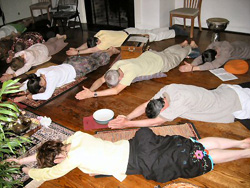 full feeling-prostration — A traditional gesture of complete surrender to the Divine, in both Eastern and Western spiritual traditions, in which one lays on the ground face down and fully stretched out, with one's arms extended fully, and one's hands pressed together. It is actually worth trying, if you never have, just to experience it! When one is in that position, one feels very different than when one is upright.
Adi Da recommends such whole bodily gestures not only as a regular part of practice, but as something to specifically engage in, particularly if one is feeling "dry" in devotion, stuck in one's head, etc. because it can very quickly "drop" one into the body, and into the feeling disposition altogether.
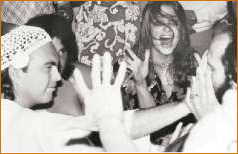
Garbage and the Goddess Period |
Garbage and the Goddess — A period of lessons during 1974 at The Mountain Of Attention Sanctuary (then known as Persimmon). The focus of those lessons was the search for self-fulfillment through both sexuality and mystical experience. Garbage and the Goddess was one of Avatar Adi Da's great Teaching Demonstrations, in which He generated a most extraordinary and sustained display of yogic, mystical, magical, psychic, and intuitive phenomena in the lives and environments of His ordinary Western devotees, who otherwise had no capacity to attain such marvels. At the same time, He drew people to a "radical understanding": He constantly drew their attention to and criticized the illusions and suffering inherent in mere experience of any kind, ordinary or sublime. Through these means, He humorously and compassionately taught them the lesson that all experience high or low is but a temporary manifestation of "the Goddess," the Shakti, or great Manifesting Power of the worlds, and should therefore be treated as "garbage" and thrown away or transcended through devotional turning to Adi Da Samraj and "radical understanding". It was a time when the principle of attraction to the Guru as the God-Man, and "Divine Distraction" by Him from self, was demonstrated as the foundation of Spiritual Life.
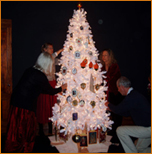 | | Giving Tree — The "Divine Spirit-Tree of Light" is Adi Da's formal name for the trees we decorate during our celebration of Danavira Mela, just as some people decorate a "Christmas tree", or a "Tannenbaum". They sometimes are called "Danavira Mela Trees" or "Giving Trees". For devotees of Adi Da, the Divine Spirit-Tree of Light is an archetype much like the "Tree of Life" that appears in many of the world's cultures. For a fuller (and delightful) presentation of Adidam's celebration of Danavira Mela, read The Danavira Mela Book. |
Gnosis — Spiritual, transcendental, or Divine knowledge; direct knowledge of the nature of Reality.
Good Company — Adi Da's term for all the people, things, and circumstances that support our life of practice of the Way of Adidam. In contrast, "bad company" refers to all the people, things, and circumstances that undermine practice. We are greatly affected by the company we keep, so devotees intentionally support their life of "radical" devotion to Adi Da by keeping Good Company. The primary "Good Company" is Adi Da Himself: receiving His Darshan, reading or listening to His Word, hearing stories of His Teaching and Blessing Work, visiting His Empowered Sanctuaries, etc. "Good Company" also includes cooperative participation in the formal community of Adi Da's devotees. The principle of "Good Company" also applies to those considering becoming Adi Da's devotees. Worldly forms of "company" (worldly people, worldly literature, the usual television, public entertainment in general, constant exposure to the materialistic, anti-Spiritual view of the world, etc.) tend to undermine one's reception of Adi Da's Blessing-Transmission and Revelation, whereas Good Company tends to support that reception. The principle of "Good Company" is not about becoming rigid (for example, never seeing a movie). It is about the development of discrimination. Also, the phrases, "Good Company" and "bad company" are not to be understood as moral judgements (e.g., people who may be "bad company" are not to be understood as "bad people"), but as functional descriptions of what supports or does not support practice. This is the Principle of Good Company: At all times, maximize Good Company and minimize bad company. (And even eliminate bad company, or, otherwise, whenever bad company cannot be avoided, do not permit that bad company to create any "compromise" in your practice of the Way of Adidam, or any "bad effect" in your life as a practitioner of the Way of Adidam.)
Avatar Adi Da Samraj, "I Am (My Self) What you Require" |
Bad company is a poison. If you must associate with bad company, you must know how to stand free of it and know how to deal with it, how to relate to it. Otherwise, you will begin to do likewise yourself.
Avatar Adi Da Samraj |
| Gopi Krishna (1903-1984) — Gopi Krishna was an office worker in Kashmir who in 1937 experienced a spontaneous awakening of the kundalini energy. He went on to write several well known and popular books about his experiences of kundalini and about his theories of its relationship to the evolution of mankind's potential. | |  |
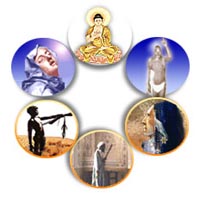 | | Great Tradition — Avatar Adi Da Samraj's term for the total inheritance of human, cultural, religious, magical, mystical, Spiritual, and Transcendental paths, philosophies, and testimonies from all the eras and cultures of humanity — which inheritance has (in the present era of worldwide communication) become the common legacy of humankind. |
gross personality, deeper personality — The gross personality is that aspect of the body-mind which is the biological inheritance from one's parents. It is related to the generally physical, lower mental, and lower psychic dimensions of the person. It simply dissolves at death.
The deeper personality is related to the higher mental, higher psychic, and spiritual functions of the person, as well as the "I"-consciousness. It is the aspect of the person that is passed on in the reincarnation process.
gross, subtle, causal — Avatar Adi Da has confirmed the three traditionally described dimensions of the human body-mind and its environment:
The gross is the material and physical dimension of existence. It is associated with the waking state.
The subtle dimension includes the etheric (or energetic), lower mental (or verbal-intentional and lower psychic), and higher mental (or deeper psychic, mystical, and discriminative) functions. It is associated with the dream state and meditative experiences. It is senior to and pervades the gross dimension.
The causal dimension is senior to both the subtle and gross. It is the root of attention, or the essence of the separate and separative ego-"I". It is associated physically with the right side of the heart, and in consciousness with the formless awareness of deep sleep. |
For Avatar Adi Da's discussion of the gross, subtle, and causal dimensions, see Santosha Adidam: The Essential Summary Of The Divine Way Of Adidam, Part Three, section III.
gunas — The Hindu texts suggest that manifest existence is a complex variable of three qualities or "gunas": tamas, rajas, and sattva. Tamas (or the "tamasic" quality) is the principle or power of inertia. Rajas (or the "rajasic" quality), is the principle or power of action or motivation. Sattva (or the "sattvic" quality) is the principle or power of equilibrium or harmony. The manifest spiritual process is a spontaneous or intended purification of the living being, wherein it is first relieved of the limiting powers of tamas and rajas, so that it takes on the sattvic quality. Then even the sattvic quality is released into the unqualified Divine Nature.
Guru — Esoterically, the word "guru" is understood to be a composite of two words, "destroyer (ru) of darkness (gu)".
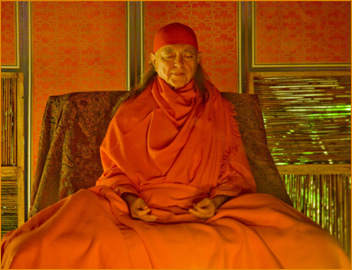
Adi Da Guru Purnima, July 18, 2008 |
Guru Purnima — Traditionally, the time of the full moon in July coincides with celebrations of the Guru — known as Guru Purnima ("Purnima" means "full moon" in Sanskrit) — and great pilgrimages around the world by devotees to sacred ashrams. For Avatar Adi Da's devotees, it is always a time of extraordinary fullness and joy, which we refer to as Da Purnima or Adi-Guru Purnima or Adi Da Guru Purnima.
Gurukula — The Guru's household or family.
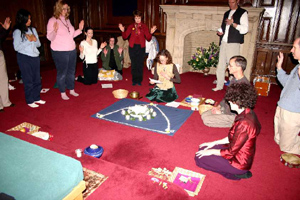
devotees celebrating Guruvara together |
Guruvara — More fully, Adi Da Guruvara. The Sanskrit word, "Guruvara", literally means "Day of the Guru". (Thus "Guruvara Day" is redundant.) Adi Da Guruvara is a weekly day of retreat (usually observed on Sunday) when all formal practitioners of the Way of Adidam celebrate and cultivate their devotional and spiritual relationship with Adi Da. It is a day of dropping out from the usual commitments of worldly life: minimizing socializing and unnecessary speech, simplifying the diet, and maximizing devotion. Ideally, Guruvara is engaged with a group of devotees rather than individually, because the Invocation of Adi Da is generally far more potent when done collectively.
Hatha Yoga — The system of Yoga commonly recognized for its physical postures and breath exercises. It is traditionally practiced, however, as a complete spiritual as well as physical discipline. As a defined system of Yoga, it was introduced in India in the 15th century C.E. by Swami Swatamarama.
hearing — Hearing is one of the major milestones of progress in the Way of Adidam. Listening is the process that precedes hearing, involving increasing disciplines, devotion, and self-understanding. Hearing occurs when the "listening" devotee understands the ego at a fundamental level, such that the mechanism of self-contraction can be recognized in any moment and felt beyond and the devotee can fully Commune with Avatar Adi Da. Hearing is the culmination of the process Adi Da calls the "listening-hearing process".
heart, stations of the heart — Avatar Adi Da distinguishes three stations of the heart, associated respectively with the right side, the middle, and the left side of the heart region of the chest. The middle station of the heart is what is traditionally known as the "anahata chakra" (or "heart chakra"), and the left side of the heart is the gross physical heart. Avatar Adi Da Samraj has Revealed that the primal psycho-physical seat of Consciousness and attention is associated with what He calls the "right side of the heart". He has Revealed that this center (which is neither the heart chakra nor the gross physical heart) corresponds to the sinoatrial node, or "pacemaker", the source of the gross physical heartbeat in the right atrium (or upper right chamber) of the physical heart. In the Process of Divine Self-Realization, there is a unique process of opening of the right side of the heart — and it is because of this connection between the right side of the heart and Divine Self-Realization that Avatar Adi Da uses the term "the Heart" as another way of referring to the Divine Self.
The Heart Itself is Real God, the Divine Self, the Divine Reality. The Heart Itself is not "in" the right side of the human heart, nor is it "in" (or limited to) the human heart as a whole. Rather, the human heart and body-mind and the world exist in the Heart, Which Is the Divine Being Itself.
heart-Communion — "Heart-Communion" with Avatar Adi Da is the practice of Invoking and feeling Him. It is "communion" in the sense that the individual loses sense of the separate self in the bliss of that state, and is thus "communing intimately" (in a most profound and non-dual manner) with Avatar Adi Da Samraj.
heart-recognition — The entire practice of the Way of Adidam is founded in devotional heart-recognition of, and devotional heart-response to, Ruchira Avatar Adi Da Samraj as the Very Divine Being in Person.
The only-by-Me Revealed and Given Way of Adidam (Which is the One and Only by-Me-Revealed and by-Me-Given Way of the Heart) is the Way of life you live when you rightly, truly, fully, and fully devotionally recognize Me, and when, on that basis, you rightly, truly, fully, and fully devotionally respond to Me. . . .
If you rightly, truly, fully, and fully devotionally recognize Me, everything "in between" vanishes. All of that is inherently without force. In heart-responsive devotional recognition of Me, a spontaneous kriya of the principal faculties occurs, such that they are loosed from the objects to which they are otherwise bound — loosed from the patterns of self-contraction. The faculties turn to Me, and, in that turning, there is tacit devotional recognition of Me, tacit experiential Realization of Me, of Happiness Itself, of My Love-Bliss-Full Condition. That "Locating" of Me opens the body-mind spontaneously. When you have been thus Initiated by Me, it then becomes your responsibility, your sadhana, to continuously Remember Me, to constantly return to this devotional recognition of Me, in which you are Attracted to Me, in which you devotionally respond to Me spontaneously with all the principal faculties.
|
For more on heart-recognition of Adi Da as the Divine Person, click here.
Heroic — The Tantric traditions of Hinduism and Buddism describe as "heroic" the practice of an individual whose impulse to Liberation and commitment to his or her Guru are so strong that all circumstances of life, even those traditionally regarded as inauspicious for Spiritual practice (such as consumption of intoxicants and engagement in sexual activity), can rightly be made use of as part of the Spiritual process.
Avatar Adi Da's uniquely "Heroic" Ordeal, however, was undertaken not for His own sake, but in order to discover, through His own experience, what is necessary for all beings to Realize the Truth. Because of His utter Freedom from egoic bondage and egoic karmas, Avatar Adi Da's Sadhana was "Heroic" in a manner that had never previously been possible and will never again be possible. As the Divine Person, it was necessary for Him to have experienced the entire gamut of human seeking, in order to be able to Teach any and all that came to Him.
Avatar Adi Da has Instructed that, because of His unique "Heroic" Demonstration, His devotees can simply practice the Way He has Revealed and Given, do not have to attempt the (in any case impossible) task of duplicating His Ordeal.
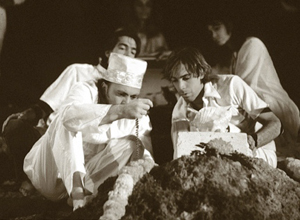
Empowerment of Holy Cat Grotto: September 17, 1979 |
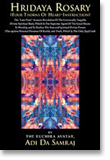
Hridaya-Avatar — "Hridaya" is Sanskrit for "the heart". It refers not only to the physical organ but also to the True Heart, the Transcendental (and Inherently Spiritual) Divine Reality. "Hridaya" in combination with "Avatar" signifies that Avatar Adi Da is the Very Incarnation of the Divine Heart Itself, the Divine Incarnation Who Stands in, at, and as the True Heart of every being.
Hridaya-Samartha Sat-Guru — "Hridaya-Samartha Sat-Guru" is a compound of traditional Sanskrit terms that has been newly created to express the uniqueness of Avatar Adi Da's Guru-Function. "Sat" means "Truth", "Being", "Existence". Thus, "Sat-Guru" literally means "True Guru", or a Guru who can lead living beings from darkness (or non-Truth) into Light (or the Living Truth).
"Samartha" means "fit", "qualified", "able". Thus, "Samartha Sat-Guru" means "a True Guru who is fully capable" of Awakening living beings to Real-God-Realization.
The word "Hridaya", meaning "heart", refers to the Very Heart, or the Transcendental (and Inherently Spiritual) Divine Reality.
Thus, altogether, the reference "Hridaya-Samartha Sat-Guru" means "the Divine Heart-Master Who Liberates His devotees from the darkness of egoity by Means of the Power of the 'Bright' Divine Heart Itself". Avatar Adi Da has Said that this full Designation "properly summarizes all the aspects of My unique Guru-Function".
Hridayam — "Hridayam" is Sanskrit for "heart". It refers not only to the physical organ but also to the True Heart, the Transcendental (and Inherently Spiritual) Divine Reality. "Hridayam" is one of Avatar Adi Da's Divine Names, signifying that He Stands in, at, and as the True Heart of every being.
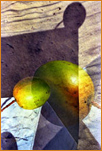 | | Image-Art, Divine Image-Art — Especially referring to Avatar Adi Da's Art Work since 1999, in which He uses photographic negatives and digital images as "blueprints" for the fabrication of monumental art-forms. For more information about the Transcendental Art-Work of Adi Da Samraj, please click here. |
Instrumentality — Avatar Adi Da uses the terms "Instrumentality" and "Instruments" to indicate the collective of His devotees who devotionally recognize and respond to Him as the Divine Person: "All those who devotionally recognize Me must work at the whole-bodily-response-position, or the position of Instrumentality and implementation." Most obviously, these are devotees in the advanced stages of practice: "In terms of My Own Work, I must be active developing Instrumentality and Agency. This means I need a body of devotees, level two and beyond." Of particular importance are devotees in the Ruchira Sannyasin Order, especially those in the seventh (or Fully Enlightened) stage of life. They are fully accountable to Adi Da Samraj and profound in their devotional recognition of and response to Him. Because they are thus conformed to Him and therefore transparent to Him, they can function as a collective "point" of contact for His Spiritual Blessing-Work, and as a means of focusing the devotional resort to Him: | You must all become energetic in your devotion to Me. You must all become un-knowable to yourselves in the Play with Me. You must all become so disturbed in your center that you have no reach to yourself — but in spite of your reach, in your simplest activities, you express Me without knowledge. This Is the Force of My Intrusion upon Which I Depend, and by Which My Continuation is Guaranteed. Avatar Adi Da Samraj, The Eternal One, p. 204 |
Note: Adi Da Samraj often uses "Instrumentality" and " Agency" as complements of each other. The creation of sufficient Agency and Instrumentality has been Adi Da Samraj's primary means for replicating His Pattern here and thereby ensuring the survival of Adidam in perpetuity.
intimate partner — A term Avatar Adi Da's devotees use to describe their "significant other", whether or not legally married.
intimate Yogic friendship — This is a technical term in Avatar Adi Da's Teaching which describes a special form of "true Yogic intimacy". In Adidam, all emotional-sexual intimacies are meant to be a discipline of mutual self-transcending love in the context of devotion to Avatar Adi Da Samraj. In "intimate Yogic friendship", the "intimate friends" relate to one another without any conventional practical or emotional expectations, as they each are "single" with Adi Da Samraj and most intensively engaged in service to Him, as well as in the other disciplines of practice.
Ishta-Guru — Sanskrit for "chosen Guru". The core practice of "radical" devotion in the Way of Adidam is also sometimes called "Ishta-Guru Bhakti Yoga": the practice (or yoga) of devotion (Bhakti) to one's chosen Guru, Adi Da.
jiva — In Hinduism and Jainism, a jiva is a living being, or more specifically, the immortal essence of a living organism (human, animal, fish or plant etc.) which survives physical death. It has a very similar usage to atma, but whereas atma refers to "the cosmic self", jiva is used to denote an individual "living entity" or "living being" specifically. The word itself originates from the Sanskrit Jivás, with the root jīv-, "to breathe".
Kali Yuga — "Yuga" is a traditional Hindu term meaning "era" or "epoch" of cosmic time, generally encompassing 12,000 years. The "Kali Yuga" is traditionally understood to be the last or final and most difficult and "dark" epoch of the cosmic cycle of time — which, it is said, we are presently experiencing. Avatar Adi Da refers to the present time as the "late-time" or ("dark") epoch, in which doubt of God (and of anything at all beyond mortal existence) is more and more pervading the entire world, and the self-interest of the separate individual is more and more regarded to be the ultimate principle of life.
Kanya — Sanskrit: "A young woman given to the Divine." A title given by Adi Da in 1988 to four women devotees who showed exemplary devotion to Him, and who, on that basis, were able to confess their true renunciation in response to the magnification of His Revelation and Blessing that was initiated by His Divine Emergence (which began on January 11, 1986). Adi Da fiercely tested the practice of His Kanyas in the traditional manner, making the point to them (and to all His devotees) that the ego is always there to be dealt with, until the seventh stage of life. As part of this process of testing, some of the Kanyas were required to leave His physical Company for brief or extended periods of time — going through deep purifications of karmic tendencies (associated with attachment to His physical form) obstructing their Spiritual growth in relationship to Him. By March 1994, Avatar Adi Da's testing of the four Kanyas had already indicated that it was most likely that only two of them had the unique depth of renunciate practice sufficient to remain in His most intimate sphere. But it was only three years later, at the end of the 1997 gatherings in the Manner of Flowers (at The Mountain Of Attention), that Adi Da indicated that this comprehensive testing was over. On March 7, 1997, Avatar Adi Da indicated that the Yogic and Spiritual Union with Him manifested by Ruchiradama Quandra Sukhapur Rani and Ruchiradama Nadikanta had become full, irrevocable, and unique.
| kava ceremony — Also known as a Sevu Sevu ceremony. A traditional Fijian ceremony which makes use of kava (from the yaqona plant), brewed for sacramental use in traditional sitting circles and fire walking ceremonies. The kava is prepared in a special kava bowl, and participants in the ceremony use a cup to drink from the bowl. In Fijian culture, most important undertakings or events are accompanied by a kava ceremony. | | 
Adi Da participating in a kava ceremony |
kirtan (Sanskrit: "to repeat") — As the term is used in Adidam, a form of chanting that involves vigorous physical engagement:
There is a difference between [ordinary] chanting and kirtan. Kirtan is when you use a song and chant in a rhythmic, musical manner in which people are very active — sometimes rising up from their seat, dancing and jumping and spontaneously being moved. Chant, on the other hand, is different. It is quieter in tone, and it is musically less elaborate and less rhythmic. It is, instead, repetitive.
Avatar Adi Da Samraj, March 26, 1992 |
For more, click here.
kriya — A spontaneous, self-purifying physical movement that arises when the natural bodily energies are stimulated by the Spirit-Current.
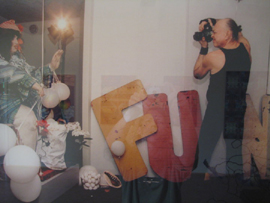
Adi Da photographing a Laughing Mama mannequin |
Laughing Mama — Used by Adi Da to refer to the indifference of conditional existence toward the fulfillment of personal desires. As He puts it, the primary communication and lesson of the Laughing Mama is: "Your objections to anything don't mean shit." The Goddess Kali in the Hindu tradition represents a similar aspect of conditional existence. (She is sometimes depicted as wearing the skulls of human beings around her neck.) The Laughing Mama image also resonates with the first half of Adi Da's "Lesson of Life": "You can never become happy. You can only be already happy." Adi Da's "Laughing Mama" image is drawn from His experience as a boy of Laughing Sal, a large, female, coin-operated, animatronic figure in the Coney Island amusement park: fat, with exaggerated makeup and bright red lipstick, freckle-faced, missing teeth, dressed in rags, and mechanized to wave her hands, rock forward and backward, and cackle hysterically.
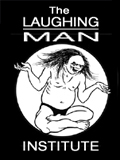 Laughing Man Institute — The Laughing Man Institute (LMI) is the public education branch of the Adidam Academy. It develops and provides a full range of public courses, lectures, retreats, and seminars about Avatar Adi Da Samraj and the Way of Adidam, and also about the Great Tradition of religion, Spirituality, and human development. Courses offered through The Laughing Man Institute allow the public to connect with Adi Da's Reality-Transmission, to get to know Him as He Is, and to benefit at heart in relationship to Him. Adi Da (the "Laughing Man" of the title) chose the name as a reference to His purpose for appearing here (recorded in Chapter 1 of Adi Da's autobiography, The Knee Of Listening): to restore humor. | From the beginning, in the early Spiritual "Brightness" of my life, I directly perceived the guiding Purpose of my life: to restore True Humor (or the all-transcending quality of Happiness, that can persist, or, otherwise, constantly come forward, in the living being under all conditions, whether the conditions appear to be positive or negative). Throughout my life, I have been moved to Communicate (or to Reveal, to Transmit, and to Awaken) the fundamental Source and Substance and Condition of True Humor to others. Ordinary humor can appear in many forms, as the seemingly undauntable mood of life-enjoyment, as the hilarious pleasure of laughter, as the fairy-tale ease of faith, as the self-congratulating certainty of mental knowledge, and as the overriding excitement of even all the greater and smaller bodily victories. But True Humor has only one living Form (and one ultimate, or inherently perfect, Form), Which is Real God, Perfect Truth, or Reality Itself. |
For more about the Laughing Man Institute, click here.
Lay Congregationist Order (LCO) — As soon as a person takes the Eternal Vow and becomes Adi Da's devotee, he or she begins to participate as a student-beginner in the Lay Congregationist Order of Adidam Ruchiradam. As a member of the Lay Congregationist Order one is a part of the second congregation, which accounts for the great majority of Avatar Adi Da's devotees, those who embrace the Way of Adidam in the lay context of ordinary life-obligations. Some devotees, at the point of readiness for the ultimate stages of practice of Adidam, may be invited to enter the first congregation of Adidam Ruchiradam. At this point, they relinquish their lay status and become legal renunciates as members of the Ruchira Sannyasin Order.
laying on of hands — An ancient practice of healing through touch, adapted by Adi Da Samraj and given to His devotees in a specific technical form that involves invocation of Him and His Blessing for the sake of that healing. For many years, Adi Da began each day doing a "Blessing Puja" for devotees in need (often with health problems), that often involved His "laying on of hands" on a photograph of the person, touching a body part that a letter has indicated requires healing. (Alternatively, He sometimes would touch the body of a person nearby: hugging someone, placing His hand gently on a heart or a head, or gently stroking a face.) I begin each day by receiving requests for Blessing from devotees. Their requests are sometimes relative to difficulties of their own, such as health problems, or other matters.
Sometimes they are requests for Blessing on behalf of people to whom they are somehow related. I am always given pictures of them. And something is said to Me about whatever is the problem, and what is actually being requested.
This is what I do at the beginning of each day — give My Blessing-Regard to people and conditions of various kinds, using a visual association.
I extend Myself through this Regard profoundly — I Intervene, I participate in the conditions in which people are suffering.
And My Blessing does purify. It can be integrated with conditions in such a fashion that conditions are changed in various ways. This is how I Work.
|
Leela — A traditional Sanskrit word for a story of "Divine Play", of the Guru or the Divine in any of His or Her forms. In Adidam, a leela is a story about the relationship with Adi Da Samraj, the Transcendental and All-Pervading Divine Person, alive in Human Form to Bless all beings — a story about receiving and being transformed by that Blessing. The Historic Me-Revealing Divine Leelas Of My Avataric-Incarnation-Time Must (Now, and Forever Hereafter) Be Told (and Re-Told) To Every Heart—and, Thereby, Be Made Alive To Reveal Me To every one, and To Teach every one The Truth Of Me, Again and Again. . . All My Devotees Should Always Tell and Celebrate My Avatarically Self-Manifested Divine Leelas (or The Revelation-Stories Of My Divine Avataric "Play" and Life), So That all who Listen To Them May Be Refreshed With More Than Wonder, and With Love, and With Joy Of Heart.
|
The Leelas told by devotees of Adi Da Samraj refer to Him, and are not just accounts of personal experience: Typically, the ego is the basis for a story: "It is my 'experience' with umpty-ump". "They came to see me, and such and such happened to them". It is a kind of 'experiential' telling. Such things may have relevance, but the basis for Leelas is recognition of Me.
A Leela is a telling of Me. It is a Revelation-Story about Me, of My Self-Revelation. It is not merely a story about something that happened to you, that you have 'experientially' integrated into something to do with your own "self"-description. That is not absolutely irrelevant necessarily, but if it is not truly about recognition of Me and profound responsiveness to Me, then it will inevitably be integrated with ego-language, because humanly-designed language is ego-based. It is based on the pronoun, the "self"-reference, and the "objective" reference to what is not "self". All language that humans invent, fundamentally, is based on this ego-principle.
It is something like the principle of perspective used in artistic rendering in conventional realism. Simply open your mouth and talk — or merely be thinking — and that is a rehearsal of the principle of egoity, or "point of view". So if Leelas are told, they tend to be told from "point of view".
Tell My Leela and not your story. Leelas are not about your adventures or your insights.
Do not merely reminisce about extraordinary "experiences" and amusing remarks or exchanges.
Leelas are not about some encounter you had with Me that brought about some change in your practice. The fundamental form of Leela is simply telling about the Guru — just that, describing the Divine Avataric Play Itself — not combined with you, but just As It Is, just As I Am, just As I Do.
Leelas that are simply about My so-called "effect" on you are ways for you to refer to Me while still talking about yourself. There can be some usefulness in that, but it is not the greatest form of Leela-telling.
The Leela should be a story that brings people to Me on the basis of knowing what I am all about altogether.
The Leelas of Mine are about Me and not about you. Leelas are about My Play, My Activities, My Work with people.
True Leelas, My Divine Avataric Leelas, are Leelas told in recognition-response to Me. They are intrinsically ego-transcending tellings of My stories. Therefore, you have to know the difference between true Leelas Literature, Divine Avataric Leelas Literature, and people simply telling about their own adventures or their own insights.
Avatar Adi Da Samraj, July 29, 2008 |
| lion at the gate — A traditional metaphor Adi Da uses for means to help keep away people who are not yet ready for spiritual practice, or means for instructing them about what is required of them if they do choose to "pass through the gate". The metaphor has its roots in the centuries-old architectural practice of placing lions at temple or palace gates. Because of their size and strength, lions were symbols of protection, used to represent or invoke powers that would help keep away enemies from places of secular power, and fools from places of spiritual power. Lions at gates were common in ancient times in the Middle East (see "The Lion as Guardian of the Gate, Temple, Palace" in Brent Strawn, What Is Stronger than a Lion? Leonine Image and Metaphor in the Hebrew Bible and the Ancient Near East) and the Far East (e.g., the Chinese "Guardian Lions", or "Lions of Buddha" - see picture - that date from the Han Dynasty in 200 BC). | | 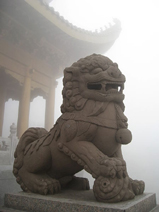 |
listening — Hearing is one of the major milestones of progress in the Way of Adidam. Listening is the process that precedes hearing, involving increasing disciplines, devotion, and self-understanding. Hearing occurs when the "listening" devotee understands the ego at a fundamental level, such that the mechanism of self-contraction can be recognized in any moment and felt beyond.
lovo ceremony — A traditional (and magnificent) Fijian feast, cooked in an underground oven called a lovo. Wood and large, flat stones are placed in a big hole. The stones are heated until they are red hot. The remaining wood is removed and the stones out are spread out until they are flat. Then the food is wrapped in banana leaves and placed onto the hot stones, largest items first. The food is covered with more banana leaves, coconut stalks, and damp burlap sacks, and left to cook for about two hours.
Mahamantra — (Sanskrit: Great Mantra) The mantra, "Om Ma Da", was the original Mahamantra given by Adi Da to His devotees, as "an acknowledgement, an invocation, and a means of communion with Me." Since then, He has provided many more mahamantras.
"Om Ma Da" . . . Is Epitomized (and Ended) In "Da", and (Thus) In Me — As The One (and Perfectly Subjective, and Self-Evidently Divine) Condition That Is Self-Existing (or Eternally, Merely Present As The Non-conditional, or Transcendental, and Inherently egoless Self-Condition), Self-Radiant (or Inherently Radiant), Infinite (As all-and-All-Surrounding and all-and-All-Pervading Divine Spirit-Power), and Always Alive As My Love-Blissful Divine Spiritual Body For The Sake Of The "Bright" Divine Liberation Of all conditionally Manifested beings.
|
For an extraordinary recording of Adi Da intoning this Mahamantra, accompanied by a background track of His playing the tamboura, click here.
Mahayana — Literally the "Great Vehicle", it is currently one of the three major branches of Buddhism in the world (along with Hinayana Buddhism and Vajrayana Buddhism). Mahayana Buddhism is an expansion of the original, nontheist form of Buddhism which focuses on the release of suffering and personal enlightenment. In Mahayana Buddhism, the Buddha has become a revered God-Man.
 | | mala — Also known in certain traditions as a rosary or prayer beads. Used to serve contemplation of the Divine through repeating prayers or invocations of a name of God, one per bead. Worn by devotees of Adi Da as an aid in remembering Him. A flower mala is a mala made entirely of flower petals. Flower malas are often placed around a photograph of Adi Da the way a flower lei is placed around a person's neck in the cultures of the South Pacific. |
Mana — A term used in South Pacific cultures to refer to the spirit force or energy that resides in people, animals, or objects. Those within the culture who are deemed to have more mana are often accorded more respect or authority.
| Marpa (1012-1097 C.E.) — Also known as "Marpa the Translator". Through the ordeal of his three trips to India, Marpa is credited with the transmission of many Buddhist teachings to Tibet from India, including the teachings and lineages of Vajrayana and Mahamudra. His Guru was Naropa, and his most famous disciple was Milarepa. Marpa was well-known for having putting his disciple Milarepa through an enormously difficult ordeal in order to prepare him (Milarepa) to receive the Buddhist Teachings. | | 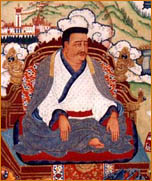 |
Mate Moce — Pronounced MAH-tay MOH-thay. The death and dying ministry of Adidam, established in 1982. In Fijian, "Mate" means "death" and "Moce" means "sleep". Dying in one's sleep is considered to be a peaceful way to die by Fijians. For this reason, Adi Da chose the name, Mate Moce, as a Fijian equivalent to His book title, "Easy Death".
Adi Da created the Mate Moce Ministry to provide general counseling to devotees in all matters related to death and dying, and to offer educational services and materials to devotees and interested public individuals. In particular, Adi Da particularly intended members of the Mate Moce ministry to be trained in His Wisdom about the death transition and to serve others who are making that transition (including the practical management of the three-day vigil that follows the death of a devotee).
maya — A Sanskrit term commonly used to indicate the illusory nature of life. In its more extended sense, it also points to the infinitely interrelated and ultimately incomprehensible complexity of reality as a whole.
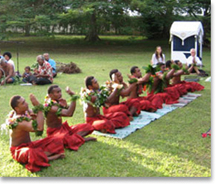
Men's meke, Naitauba | | meke — Until the early 1800s, Fiji was strictly an oral culture with no written language. Meke ("dance") was considered a gift from the Vu, the ancestral gods, to help the Fijians preserve their traditions and stories. Meke was used for instruction, memorization, and cultural education, and to explain the history of the Fijian people. |
 Midnight Sun — A term Adi Da uses to refer to His Revelation of the esoteric visionary representation of Reality as a White Sphere in a black field — which Sphere is His Own Divine Form. There Is a Sun That Is Forever Risen in the night sky of the body-mind. It Is the Eternal Sun — the (Self-"Bright") "Midnight Sun", Infinitely Above the head, and not usually perceived. . .
The Sun That Is Eternal and Over-head is not in the midst of a colored sphere of light. The Eternal "Midnight Sun" Is Beyond that sphere. The "Midnight Sun" Is, Truly, the Divine "Face" of My Threshhold Form.
|
 | | The Mountain Of Attention Sanctuary — The first Ruchira Sannyasin Sanctuary established by Adi Da (in 1974), in the early years of His Teaching Work. It is located in northern California. Much more about this Sanctuary can be found here. |
| mudra — A spontaneous gesture of the hands, face, feet, or body that outwardly expresses a state of ecstasy or Spiritual force in the body. Avatar Adi Da sometimes spontaneously exhibits mudras as signs of His Blessing and Purifying Work with His devotees and the world. | | 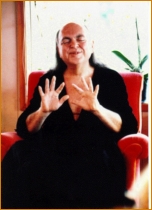 |
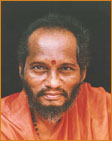 Muktananda, Swami (1908-1982) — Swami Muktananda served Avatar Adi Da as Spiritual Teacher from 1968 to 1970. He was born in Mangalore, South India. Having left home at the age of fifteen, he wandered for many years, seeking the Divine Truth from sources all over India. Eventually, he came under the Divine Influence of Swami Nityananda, whom he accepted as his Guru and in whose Spiritual Company he mastered Kundalini Yoga. In the summer of 1969, during Avatar Adi Da's second visit to India, Swami Muktananda wrote Him a letter confirming Avatar Adi Da's attainment of "Yogic Liberation", and acknowledging His right to Teach others. However, from the beginning of their relationship, Swami Muktananda instructed Him to visit Swami Nityananda's Burial Site every day (whenever He was at Swami Muktananda's Ashram in Ganeshpuri, India), and to surrender to Swami Nityananda as the Supreme Guru of the Lineage.
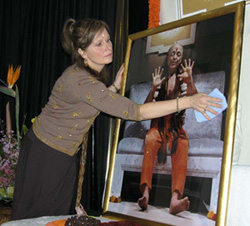
devotee doing a puja on a Murti of Adi Da |
Murti — Sanskrit for "form", and, by extension, a representational image of the Divine or of a Guru. In Adidam, Murtis (or "Murti forms") of Avatar Adi Da Samraj are most commonly photographs of Him, used by His devotees as the focus of meditation and sacramental worship.
Adi Da has also made a distinction between Murti photographs and Murti-like photographs. A Murti is typically a photograph of Adi Da taken of Him during a formal Transmission occasion. Adi Da wanted Murtis to only be used by formal devotees. Because of how a Murti is used by devotees (in meditation, puja, etc.), it also is typically a full-body image of Bhagavan. During His lifetime, Adi Da Himself would select the images that would be used as Murtis. All photos of Adi Da are capable of Transmitting Him and serving as a devotional touchpoint, and in this sense, all non-Murti photographs of Him are "Murti-like". Click here for a site that provides Murti and Murti-like photographs of Adi Da Samraj.
 | | Nâgârjuna (c. 150 - 250 C.E.) — One of the most influential figures in the history of Buddhism, Nagarjuna was an Indian philosopher and considered to be the founder of the Madhyamaka (Middle Path) school of Mahayana Buddhism. |
| Narayan Maharaj (1885-1945) — An Indian Saint who, in his play with devotees, would adopt the lifestyle of a king. He had several luxury cars and dressed in the finest clothes. His ashram at Kedgaon in southern India was run like a kingdom where he would hold court. He is also known for the Yogic ordeal he engaged for the sake of the world during World War II. He had no elaborate philosophy, but simply taught the Way of Communion with God through the Spiritual Agency of a living Master. At the peak of his Work, he is reputed to have had over a million devotees. Shortly before he died, Narayan Maharaj is reported to have said, "I came to you with nothing, and I leave you with nothing." | |  |
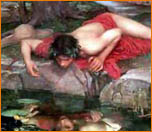 Narcissus — Adi Da uses the ancient Greek myth of "Narcissus" as a metaphor for the universal, egoic activity of separation and the avoidance of relationship. Narcissus was universally adored but scorned everyone, until he was cursed to fall in love with his own image. He stared at his reflection in a pond, eternally miserable and frustrated that he could not be with this one he adored. He did not realize that his loved-one was his own reflection; he presumed it was someone else. Yet he rejected all others in the "real" world and eventually died, solitary and self-enamored. Avatar Adi Da observed during His own life of Spiritual practice that the story of Narcissus was like a script that everyone is living constantly. Everyone is constantly thinking about his or her own suffering, seeking, or self-improvement, never inspecting the act of avoidance and contraction that is the cause of suffering. Like Narcissus, everyone persists in adoration at the pond, longing to have life work out or be better, to realize union with the presumed loved-one there. But Avatar Adi Da's teaching is about being attracted out of the self-enamored state—looking up from the pond in devotion to Him—and thus recognizing it is one's own misunderstanding that bound one to suffering in the first place. Narcissus is a good symbol for suffering. He has separated himself from all relationships, especially the primary relationships of mother, father, loved-one, and environment. He confronts only his own image, which he does not re-cognize as such. Obviously, Narcissus does not know that the face in the water is his own image. He does not re-cognize his own image, or quality, as such. And suffering is in the failure of one to re-cognize, to know again, one's own distraction, which is one's own state, one's own quality, one's own modification. When one re-cognizes it, one ceases to be enamored, fascinated, and distracted.
Avatar Adi Da Samraj, The Divine Siddha-Method Of The Ruchira Avatar |
| Naropa (1016-1100 C.E.) — Naropa was a Crazy Wisdom Adept in the Buddhist tradition that began in India and flowered in Tibet. He is remembered for his trust and devotion to his Guru, Tilopa (A.D. 989-1069). After a profound and lengthy ordeal, he attained the full realization of Mahamudra, or mind-transcendence. Naropa University was named in his honor. His best-known disciple was Marpa the Translator (A.D. 1012-1096), who introduced a refreshed form of Buddhism to Tibet that eventually developed as the Kagyu school of Tibetan Buddhism. | | 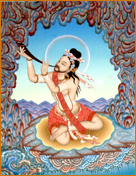 |
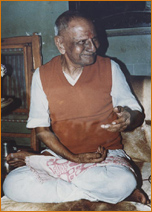 | | Nisargadatta (1897 - 1981) — A great Indian Sage, widely considered to be one of the twentieth century's most articulate communicators of the Hindu school of Advaita Vedanta or nondualism. A number of his talks were compiled into the book, I Am That, which achieved international success in 1973 with its first English translation. |
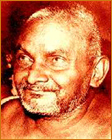 Nityananda, Bhagavan or Swami (????-1961) — A great Yogi of South India and one of Avatar Adi Da's Spiritual Teachers in His Lineage of Blessing. Little is known about the circumstances of Swami Nityananda's birth and early life, although it is said that even as a child he showed the signs of a Realized Yogi. It is also known that he abandoned conventional life as a boy and wandered as a renunciate. Many miracles (including spontaneous healings) and instructive stories are attributed to him. Nityananda surrendered the body on August 8, 1961. Although Avatar Adi Da did not meet Swami Nityananda in the flesh, He enjoyed Swami Nityananda's direct Spiritual Influence and Instruction from the subtle plane.
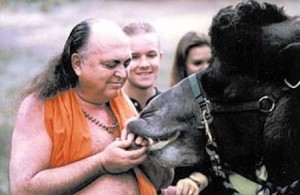 non-humans — Adi Da's term for all beings that are not human. One reason Adi Da prefers this term over more conventional ones (e.g., "animals") is that the conventional terms tend to have pejorative connotations (less than human, not as conscious or feeling as humans, second class citizens of the world, etc.) Adi Da has pointed out that not only are non-humans just as feelingly aware of the world and their own existence as we are, but in many aspects, are more rightly aligned to their Divine Reality than most human beings:
Most non-human beings, you could observe, are spending a lot of time in Contemplation. Their times of non-Contemplation are associated with some kind of physical necessity. They prefer to be in a situation of not having physical obligation. Very often this is so.
|
Ultimately, Adi Da's term, "non-humans", extends beyond even "animals", to all that is not human, whether animate or not: But the simple lesson and advice from Sri Adi Da Samraj, in regards to all non-humans, of which the Avadhoot includes trees, plants, rocks, water and everything else non-human, is expressed in a sign that hangs in the home of the precious Avadhoot of Da Love-Ananda Mahal (Adi Da's Sanctuary in Hawaii), that reads: "Be Kind To All The Non-Humans, or Else!"
|
Adi Da has always emphasized that He is here for the sake of all beings: All equally require Divine Compassion, Love, and Blessing, the thread of Communion with the Divine made certain and true and directly experienced. All. Therefore, the Sphere of My Work is all beings and things. Literally it is so. This is literally how I Work. I cannot size up one being or thing against another — the devotee against the non-devotee, the human against the non-human, the Earth against some other place. I cannot do that. I am Doing a universal Work. I Am here to receive, and kiss, and embrace everyone, everything — everything that appears, everything that is.
|
For much more of Adi Da's Wisdom about non-humans, visit the Fear-No-More Zoo website.
Notes — Adi Da's daily, oral communications to His devotees. Often Adi Da would devote many hours each day to giving Notes. The Notes would be recorded, and devotees would transcribe them as soon as possible so that printed versions could be sent to the intended recipients of the Notes in a timely fashion. Some Notes were intended for specific individuals that Adi Da named in the Notes, while others would be intended for a larger group of devotees (e.g., all devotees associated with the Adidam Mission), and some Notes were for all devotees. While most of Adi Da's Notes were addressed to His devotees, He also would communicate with non-devotees in this way as well, for example: people who were responding to Him in one way or another, or people who were collaborating with Him (exhibiting His Art, publishing His Literature, etc.). Certain devotees (in the "Communications Department") had the responsibility for communicating Adi Da's Notes to the right people in a timely fashion, and for relaying responses back to Adi Da.
The Note cycle was one of the primary means Adi Da used to bring the traditional Guru-devotee relationship into modern times. In the traditional Guru-devotee relationship, a small number of devotees lived in (or near) the Ashram of the Guru; each would encounter the Guru face-to-face on a regular, natural basis, enabling the Guru to say whatever was needed in a completely spontaneous, organic fashion. Adi Da used His daily Note cycle (combined with modern technology) to do the same thing with thousands of devotees, who were spread around the world. It was called a "Note cycle" because devotees who were addressed by Notes typically would write responses to Adi Da, and He in turn might respond to that in the next day's Notes, etc. Thus, the Note cycle was a way by which Adi Da cultivated His relationship with His devotees, and enabled them to do the same with Him. Receiving Notes from the Guru was always a Blessing (and often a responsibility as well). Many devotees would describe how they would feel the Love-Bliss of Adi Da's Regard at one point in the day, and then receive Notes from Him later the same day (e.g., by email from the Communications Department), confirming that He had indeed given them His Regard (as well as Notes) earlier in the day.
All of Adi Da's Notes were recorded (either by audio or video), and transcribed. The Adidam Archives contains tens of thousands of pages of Adi Da's daily Notesets. Those of general use for many devotees, or even non-devotees, often appeared in His published books during His lifetime, and it is likely that many more of His Notes will be published in future books.
| Nukasa — The area on Naitauba where the boats come to unload their cargo. | |  |
 oedipal patterning — Early in the twentieth century, Freud observed that emotional-sexual conflicts originate in the "oedipal" dynamic between children and their parents. He saw that one's sexual impulses, which are present even in early childhood (especially in relation to one's parents), are at the root of various emotional patterns and psychological problems. There can be no basic emotional ease or equanimity in human life until individuals achieve at least a personal resolution to this conflict, and mastery of their oedipal patterning. Adi Da has observed that such self-understanding is an essential part of the foundation of human maturation upon which genuine spiritual growth must be based: Freud wanted to bring his own emotional-sexual tendencies under the control of the social ego. Thus Freud suppressed himself — because he saw that the un-mastered emotional-sexual ego is wild and powerful. That suppressive disposition (or "point of view") is not a workable basis for Spiritual life. ("My Word To All Who Would Find Heart-Breaking Freedom", from The Complete Yoga of Human Emotional-Sexual Life, p. 25)
I Call My devotees to the transcending of any obstruction of energy, any dramatization of the "self"-contraction in relation to sex or any other aspect of life. I do not have a moralistic reaction to anything about the emotional-sexual life of human beings. To Me, emotional-sexual difficulty (of whatever kind) is simply a sign of egoity in whomever it appears — and, therefore, it is simply something that the individual must deal with in a straightforward, non-problematic, non-puritanical, and, altogether, non-paranoid (or fearless) manner. (Ibid, pp. 25-26) |
Adi Da also pointed out that the Guru-devotee relationship itself tends to be impacted by the devotee's oedipal patterning. Women devotees tended to approach Adi Da (and, indeed, all men) as "daddy" or "lover", often rejecting and betraying others, including their intimates, for access to Him. Meanwhile, men tended to approach Adi Da (and all male "others") — not only as "daddy", but as "rival" and "opponent" — competing (in the case of Adi Da) for victory over Him in all the games of life. As Adi Da describes this dynamic: | I (Myself) find that devotees tend to dramatize an "oedipal" relationship even to Me. Individuals tend to fall into a disposition toward Me in which they regard Me, psychologically, to be their father. Male devotees, therefore, tend to be in fearful (and rejection-sensitive) competition with Me, and female devotees tend to develop some kind of (rather incestuous, but also fearful, and rejection-sensitive) "girlfriend" relationship with Me. But I am neither the father (or any kind of parent) nor the "boyfriend" of My devotees. ("I Call you to Go Beyond the 'Oedipal' Sufferings of Childhood", from The Complete Yoga of Human Emotional-Sexual Life, p. 77). |
So understanding and transcending one's oedipal patterning is essential to growth in the relationship with Adi Da Samraj, and the Spiritual Realization associated with that growth.
"Open Eyes" — Adi Da's phrase for the Realization of seventh stage Sahaja Nirvikalpa Samadhi, or Most Perfect Divine Enlightenment. The phrase graphically describes the non-exclusive, non-inward, Prior State of the Divine Self-Realizer, Who is Identified Non-conditionally with the Divine Self-Reality, while also allowing whatever arises to appear in the Divine Consciousness. This term is placed in quotation marks to indicate that Adi Da uses it with the specific technical meaning described here (rather than any of the more conventional uses).
| Padmasambhava (ca. 730-805 C.E.) — An eighth-century Indian Adept credited for bringing Buddhism to Tibet. Padmasambhava's abilities and achievements were so great he is often referred to as the second Buddha. | |  |
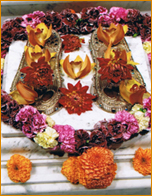 | | Padukas — A Sanskrit term that most often refers to the sandals worn by the Spiritual Master. Traditionally the Guru's Padukas are treated as one of the most sacred articles, as they represent the Guru's body itself, and are a focus for contacting the Spiritual Master's Transmission. Thus, the Guru often will give a pair of His Padukas to devotees to use in their sacramental worship. In Adidam, Avatar Adi Da empowers Padukas to be used for such purposes by placing His Feet in them, often during sacred occasions. |
| Papa Ramdas (1884-1963) — Swami Papa Ramdas was an Indian Saint from South India. He is noted for his living a devotional life of utter dependence on God. | |  |
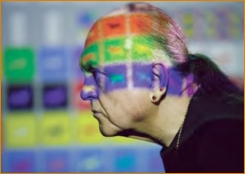
Adi Da at work in Picture Perfect. | | Picture Perfect — Adi Da's art studio on Adi Da Samrajashram.
For more pictures of Adi Da at work on His Image-Art, click here. |
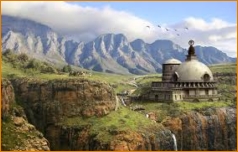
Xanadu by R. Alexander Lawrence |
Pleasure Dome — Adi Da speaks of the Way of Adidam as a "Pleasure Dome", recalling the poem "Kubla Khan", by Samuel Taylor Coleridge ("In Xanadu did Kubla Khan/A stately pleasure-dome decree . . ."). He points out that, in many religious traditions, it is presumed that one must embrace suffering in order to earn future happiness and pleasure. However, by calling His devotees to live the Way of Adidam as a Pleasure Dome, Adi Da communicates His Teaching that the Way of heart-Communion with Him is always about present-time Happiness, not about any kind of search to attain Happiness in the future.
positive disillusionment — One of the key prerequisites for actually advancing in the practice of the Way of Adidam.
Before the foundation phase (or first phase) of the ego-transcending Great Process of the only-by-Me Revealed and Given Reality-Way of Adidam can (itself) be complete, it must Realize a profoundly life-transforming and life-reorienting "positive disillusionment", or a most fundamental (and really and truly "self"-contraction-transcending) acceptance of the fact that gross conditional existence is inherently and necessarily unsatisfactory and unperfectable (and, therefore, a most fundamental — and really and truly Me-Finding and search-ending — acceptance of the fact that all seeking to achieve permanent and complete gross satisfaction of separate body, emotion, and mind is inherently and necessarily futile). Only on the basis of that necessary foundation-Realization of "positive disillusionment" can the functional life-energy and the attention of the entire body-mind-complex (or of the total body-brain-mind) be released from gross ego-bondage (or "self"-deluded confinement to the psycho-physical illusions of gross "self"-contraction).
|
Because all of us have engaged in illusions about the nature of happiness for lifetimes, it can take us quite a few years (or even lifetimes) to go through the "positive disillusionment" process. While conventionally, the word, "disillusionment", has a mixed connotation (e.g., "older but wiser"), Adi Da refers to the process associated with Him as "positive" because the disillusionment frees up one's life and destiny for a Greater Alternative. The primal illusion that positive disillusionment frees us from is the notion that we are separate selves, separate from the Divine — an illusion that Adi Da has mocked with the name, "The Dreaded Gom-Boo". To be completely relieved of that illusion is to fully Realize God, to fully Awaken in the seventh stage of life. For more, read "Perfect Dis-Illusionment" in Part 8 of The Aletheon and watch this video. See also: Lesson of Life
Prasad — A Sanskrit term meaning any offering to the Guru or the Divine that is Blessed and then returned to the devotee as a tangible expression of Blessing.
Pass the Prasad — Adi Da uses this phrase to refer to the collective obligation of all His devotees to share what has been Revealed to them by Adi Da with the rest of the world.
To make this Work grow, devotees must pass the Prasad. They must grant people their energy. They must stop killing life and holding on to information.
I gave it all away. I created it, and I gave it all away. There is enough there for thousands of people. But devotees do not understand what has been given to them. They must come to that understanding. They must be manly, and they must take this Prasad as a Gift. They must know that the Teaching Revelation has been given to many, and that I am in Communion with countless people who have not yet been notified.
It is the institution's responsibility to notify those people, to help them practice, and to encourage them to serve the institution. Devotees have inherited a great estate. They do not yet know that they are millionaires. The institution must therefore notify them. People are always coming to the Sanctuary and being surprised by the Presence there. They always say that they want to come back. Why aren't thousands of people coming there constantly as a Source of refuge? And why aren't they telling their friends about it? . . . I have given you an immense fortune. Go beyond your neurosis. Get involved with many more people. Be creative with your wealth. You have been given so much. It seems impossible to fail when you have been given so much, but you will fail if you do not recognize what you have been given.
|
See also: Prasad Day
Prasad Day — A monthly "Prasad Day" was the original form of Celebration within Adidam. Here is a description of Prasad Day from No Remedy: "Prasad Day" is held once a month at Persimmon. Prasad Day is a special community celebration of the sacrament of Satsang, or Divine Communion. On Prasad Day, Guru-seva, or the function of service to the Lord in the form of the Guru, is celebrated and made visible in a special way. It is the time when each of us comes to Bubba with a special offering, usually of fruit or flowers, symbolizing our most significant gift, which is the search.
On Prasad Day each of us acknowledges Bubba as Guru, the discovery of whom makes all seeking unnecessary. Several times every year, Prasad Day is held to commemorate some special spiritual event, such as the Realization of the Heart, or Bubba's Birthday, or Guru Day, which is a traditional annual celebration of the Guru's Presence. Those special celebrations are themselves unique versions of Prasad Day, just as Prasad Day is a unique version or celebration of Satsang itself.
Approaching the Guru: Prasad and Darshan, No Remedy |
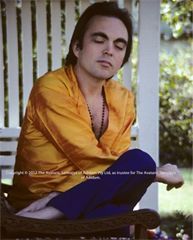 | | Adi Da sitting in Darshan in the backyard of a devotee's home in Los Angeles on a formal Prasad Day, March 11, 1973. This is the same day He Gave His beautiful landmark Communication, "The Gospel of the Siddhas", now titled The Heaven-Born Gospel of the Ruchira Avatar. | See also: prasadpremonitory texts — Adi Da refers to a handful of traditional books as "premonitory texts" — "premonitory" in the sense that certain passages in these books are suggestive of the Realization of the seventh stage of life, even while the bulk of these books do not reflect an author who is a Realizer of the seventh stage. Adi Da further clarifies:
The traditional premonitorily "seventh stage" texts are advanced sixth stage literatures that express a few philosophical conceptions, or yet limited and incomplete intuitions, that sympathetically resemble the characteristic seventh stage Disposition (in and of Itself), and thus somehow foreshadow (rather than directly reflect, or directly express) the Truly Most Ultimate (or Transcendental, inherently Spiritual, and necessarily Divine) "Point of View". Such texts communicate a "Point of View" in which discriminative intelligence and the effects of discriminative mind are completely discounted, and even made fun of, along with the practices that belong to the developmental stages of life and practice. However, none of the traditional texts otherwise communicate the truly and wholly seventh stage "Point of View" and Sign, in a form that is not mixed with or otherwise limited by the characteristic sixth stage point of view and orientation. And none of the traditional texts communicate the full developmental and Yogic details of the progressive seventh stage Demonstration (of Divine Transfiguration, Divine Transformation, and Divine Indifference). Nor do they ever indicate (or has any traditional Realizer ever Demonstrated) the Most Ultimate (or Final) Demonstration of the seventh stage of life (Which End-Sign Is Divine Translation). Therefore, it is only by Means of My own Avataric Divine Work and Avataric Divine Word that the truly seventh stage Revelation and Demonstration has Appeared, to Complete the Great Tradition of mankind.
Avatar Adi Da Samraj, "The Unique Sixth Stage Foreshadowings of the Only-By-Me Revealed Seventh Stage of Life" from The Basket Of Tolerance |
prior unity — Adi Da's term "prior unity" points to the unity that exists prior to all the apparent differences and conflicts in the world. In other words, that unity is senior to all apparent signs of disunity. Adi Da also calls this the "unifying life-principle" and the "cosmically extended pattern of Oneness". Adi Da does not use the word "prior" to mean "previous". He uses it in the sense of "a priori" or "inherent".
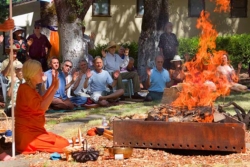
Devotees participatating in a Prosperity Puja
at The Mountain Of Attention | | Prosperity Puja — In a Prosperity Puja, participating devotees engage in a powerful, collective form of the Devotional Prayer of Changes and sacramental worship of Adi Da. It is a time when the participants specifically visualize abundance and growth and relinquish all presumed limitations to prosperity. During the Puja, the name of each individual who participates is read and offered into the Fire. For stories from devotees about the Adidam Prosperity Puja, click here.
See also: puja |
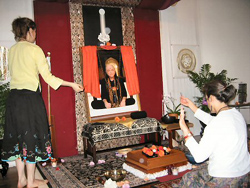 puja — Sacramental worship and invocation of the Divine in a bodily active form, including waving lights and incense, washing and anointing an Image of the Divine (or by extension an Image of one's Spiritual Master regarded to be Divine), offering flowers, and so on. Devotees of Adi Da Samraj do this in relation to "Murti" photographs of Him, and in very special occasions in relation to Him directly, bodily, in person. By extension, all outward directed activities (as opposed to meditative activities) are to be done as puja, or Invocation of the Divine. For example, devotees will often say they are doing something "as a puja", meaning doing it in the intentional disposition of calling upon or invoking Divine Help and Blessing for a specific accomplishment. In the Way of Adidam, the secret is to do puja in relation to Me, the Avataric Incarnation of Real (Acausal) God, such that I, As I Am — My Perfect State — am Moved to Respond to your ritual. The secret is not in performing the ritual correctly. You cannot perform the ritual only and expect the puja to do the work. The Divine Responds to you only if you really respond to the Divine. Avatar Adi Da Samraj |
In addition, a puja must be performed in a creative, participatory manner, rather than as a mere mechanical ritual. One must invest oneself in it: Ceremony is an art, you see. You must be loose, even have a certain sense of humor without otherwise losing your connection with what you are doing. The ceremonial art should be something done really, not just done apparently. You must fully participate in the process, and that means you must be loose, like an artist making a painting. Only if you engage it as an art can you be attentive to the real details of the process rather than the mechanical details. You can play it freely. You can dance it. Religious ceremony is an art. Avatar Adi Da Samraj |
This is the secret of effective puja: to participate in the world as a psychic phenomenon, not as a something you hammer out with your left brain, hoping that something will happen as a result of your merely external, physical acts. You must awaken to the psychic plastic of the waking state and realize that through changes of attitude, through surrendering things in the Divine, you can make changes in experience and the world. You must have the same free and liberal attitude as when you are awake while dreaming. You know that the dream figures are hallucinations and that when you can freely change your mind or attitude, all of a sudden conditions change. Avatar Adi Da Samraj |
The term "Pazooza Puja" (humorously coined by Adi Da) refers to a special intentional disposition (and event) for raising money for sacred purposes. When devotees refer to Avatar Adi Da's Puja, such as in "His Blessing Puja", it is used to indicate His Intentional Intervention as the Divine to infuse and transform a particular circumstance or condition. pujarist: one who performs a puja. puja article: an item that is used during a puja. See also: Paduka Puja, Circumambulation Puja, Purification Puja, Prosperity Puja, Fire Puja.
Purification Puja — Adi Da created Purification Pujas for the purpose of psychically cleansing an environment, and helping any discarnate spirits "stuck" in the environment to move on. While Purifications Pujas can be performed whenever they are useful or needed, they are regularly performed by devotees (in devotee homes and in sacred environments) twice a year: in spring, and on October 31 (associated with the secular celebration of Halloween, or "All Souls Day"). Here is the Admonition associated with the Purification Puja:
| This is the Sacred Domain of the Divine Avataric Master, Adi Da Samraj, Who has Restored Happiness to the cosmic domain and Revealed and Given the Liberating Way of Adidam for all beings. This is no longer your home or place to be. You are dead, and with the Blessing of the Divine Person, Who Is Da, leave now. Relax and continue your growth and destiny in the Great Process. So, do not struggle. Have no regrets. Go! |
For more on Adi Da's wisdom about discarnate spirits, read our article, About Ghosts. For more about Purification Pujas, click here. See also: Puja.
Purusha — In the Sutra literature of Hinduism, the Purusha is the "Self" that pervades the universe. The Vedic divinities are interpretations of the many facets of Purusha. In Samkhya, a school of Hindu philosophy, Purusha is pure consciousness. It is thought to be our true identity, and is contrasted with Prakriti, or the material world.
Quandra Mai — One of the names previously used to refer to members of the sacred order of renunciate women directly serving Beloved Adi Da Samraj. Other names have included "Kanyas", "Quandra-Devi", and "Adidama Quandra Mandala".
"radical" — Avatar Adi Da uses the word "radical" to mean "gone to the root" (Latin: "radix" = "root"), rather than the conventional political meaning.
"radical" devotion — Formerly known as Ruchira Avatara Bhakti Yoga. The fundamental practice [yoga] of devotees of Adi Da Samraj. It involves moment to moment devotional turning of the four principal faculties (of mind, emotion, breath, and body) to Adi Da Samraj, or invoking, feeling, breathing, and serving Him in every moment, based on devotional love of Him and devotional recognition of Him and response to Him as the Divine. Adi Da originally described this practice as "Ishta-Guru-Bhakti Yoga", a traditional phrase meaning devotion ("bhakti") to one's chosen ("Ishta") Guru.
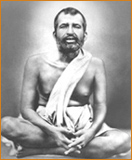 | | Ramakrishna Paramahansa (1836-1886) — Well-known in the West, the Indian Spiritual Master Ramakrishna was an ecstatic, and a lifelong devotee of the Goddess Kali, a form of the "Mother-Shakti". In the course of his Spiritual practice, Ramakrishna spontaneously embraced many different religious and Spiritual disciplines, eventually Realizing a state of profound mystical union with the Divine. Avatar Adi Da Reveals the unique Role of Ramakrishna (and his chief disciple, Swami Vivekananda) as the Deeper Personality Vehicle of His (Avatar Adi Da's) Avataric Incarnation in The Knee Of Listening. |
| Ramana Maharshi (1879-1950) — A great Indian Sage, who became Self-Realized at a young age and gradually assumed a Teaching role as more people approached him for Spiritual guidance. Ramana Maharshi's Teaching focused on the process of introversion (through the question "Who am I"?), which culminates in conditional Self-Realization, exclusive of phenomena. He established his Ashram at Tiruvannamalai in South India, which continues today. | | 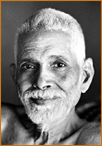 |
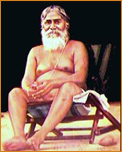 | | Rang Avadhoot (1898-1968) — A great Indian Yogi and Saint. During Adi Da's first trip to India, in 1968, he had a brief but significant encounter (a passing sighting) with Rang Avadhoot in Swami Muktananda's garden. This event is described in The Knee of Listening and in Avatar Adi Da Samraj's essay "I Alone Am the Adidam Revelation" sections XLVII and XLVIII, which appears in many of Adi Da's "Source-Texts". |
| rangoli — Rangoli is an art form originating in the Indian subcontinent, in which patterns are created on the floor or the ground, using materials such as colored sand, colored rice, dry flour, or flower petals. Rangolis traditionally have been made during sacred Hindu Celebrations. Adidam continues the rangoli tradition for its major sacred Celebrations. | | 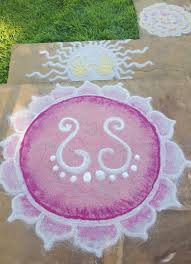
a sand rangoli made for Da Purnima |
 | | Raymond's Problem — This phrase alludes to one of the main themes in Avatar Adi Da's Mummery Book. "Raymond's Problem" is the archetypal dilemma of loving someone with the full knowledge that that person will eventually die. Adi Da Teaches that Raymond's Problem is resolved only in the Spiritual Realization of non-separation. This is fully depicted in the book. |
Real God, Real (Acausal) God — Avatar Adi Da uses these terms to refer to the "God" Which Is Reality or Truth Itself, not a conventional theistic "God", or the God conceived of as having "created" the world or "causing" things to happen.
| Red Sitting Man — A sacred fire site at The Mountain Of Attention Sanctuary, Empowered by Adi Da on November 3, 1979. It is an area of the Sanctuary that is made of ash-white volcanic rock, shaped in the form of a massive natural fire-pit. In July of 1979, Adi Da Initiated devotees there in the sacramental worship of Him in the form of fire. Fire is one of the most powerful elemental symbols of the Divine — a sign of Spirit, Light, and purification. For more about this site, read The Hole in the Universe: The Sacred Empowerment of Red Sitting Man. Red Sitting Man is also mentioned in Look the Fire in the Eye. | | 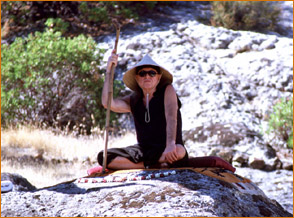
Adi Da Samraj at Red Sitting Man, 2002 |
religious provincialism — A phrase Adi Da coined for the lack of awareness of (or detailed knowledge of, or respect for) any religious or spiritual tradition other than one's own.
Religious provincialism leads to false dichotomies, such as the notion that if one can't believe in the Creator God, one's only other alternative is to believe there is no God — whereas, in fact, God could exist and be Something entirely different from the "Creator God".
Adi Da identified religious provincialism and scientific materialism as two of the primary liabilities of contemporary civilization.
renunciation — Many spiritual traditions associate renunciation with some form of body-denying and life-denying asceticism. Avatar Adi Da observes that such practices are still ego-based, and therefore do not transcend the ego itself. When Adi Da refers to renunciation, He means "true and free renunciation", in which the movement toward "self"-fulfillment through ordinary means inherently falls away because egoic "self"-identification with the body-mind-complex and its "objects" is transcended in love-bliss-communion with the Divine. Conventional "renunciation" dissociates from the body and life in a search for the Divine (or for some greater-than-normal state). In contrast, true and free renunciation is not a search. It is based on already locating the Divine, and — on that basis — spontaneously and naturally letting go of old patterns of "self"-fulfillment, because they are no longer necessary or compelling.

Robert the Cat (photo taken by Adi Da) |
Robert the Cat — In His autobiography, The Knee Of Listening, Adi Da describes Robert the Cat as His first teacher: | Robert himself was nothing less to me than my best friend and mentor. He was more, not less, than human to me. I watched him with fascination. I followed him through the woods and watched him hunt. I tried to understand his curious avoidance of the sea, and how he could sit on the cliff above the sea, watching the evening sun, and the wind blowing his hairs heroically about his head. The mystery of his pattern of living, his ease and justice, the economy of all his means, the untouchable absence of all anxiety, the sudden and adequate power he brought to every circumstance without exceeding the intensity required, all of his ways seemed to me an epitome of the genius of life. And he communicated with me so directly that I was disarmed. He would call me when he returned in the evening. He would touch me whenever he needed my presence. He would lie with me as if with conscious intention to console me with his living presence. And I loved him as deeply as the universe itself. |
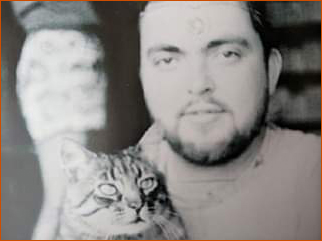
At The Mountain Of Attention Sanctuary is an outdoor Temple named "Holy Cat Grotto", which honors Robert and his relationship with Adi Da Samraj, and holds Robert's ashes: | I recognized that Robert had been my teacher in the wilderness. He had filled my eye and owned a thread of attention in my heart. I Knew him and he Knew me. Nothing could replace that state of life or console its absence. I treated him in death like a saint. I had him cremated, and I kept his ashes. |
Holy Cat Grotto is a wild and profound place of healing and meditation.
| Ruchira Dham Hermitage — Sanskrit: "The Abode of Brightness". The house on Lopez Island, Washington, where Adi Da was staying when the Ruchira Dham Event occurred on April 12, 2000. Now Adi Da's renunciate Hermitage. For more, click here. | |  |
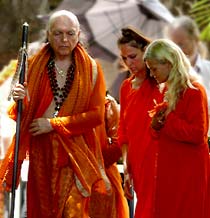 Ruchira Sannyasin Order (RSO) — More formally: The Naitauba Ruchira Sannyasin Order of Adidam Ruchiradam. (Previous names: Free Renunciate Order, Free Sannyasin Order.) The senior renunciate order of Avatar Adi Da's most advanced devotees (along with Adi Da Samraj Himself) who have legally renounced all property and devoted themselves entirely to Spiritual and Divine purposes. The Ruchira Sannyasin Order is the senior of the two formal renunciate orders in Adidam. (The other is the Lay Renunciate Order.) "Ruchira" is a title for all members of the Ruchira Sannyasin Order who are practicing in the context of the sixth stage of life, and indicates "a true devotee of the Ruchira Avatar, the Da Avatar, the Love-Ananda Avatar, Adi Da Samraj, who is, by His Grace, becoming Radiant, or 'Bright' with Love-Bliss, through uniquely one-pointed (self-surrendering, self-forgetting, and self-transcending) feeling-Contemplation of Him, and, Thus and Thereby, of the True Divine Person" (from "The Orders of My True and Free Renunciate Devotees", Eleutherios). "Naitauba" is the traditional Fijian name for Adidam Samrajashram, the Great Island-Hermitage of Avatar Adi Da Samraj. As a general rule, all members of the Ruchira Sannyasin Order are formal residents of Adidam Samrajashram. Adi Da has indicated that the members of the Ruchira Sannyasin Order collectively function as His "Instruments", allowing Him to Magnify His Transcendental Spiritual Work for all time: I Work through My Ruchira Sannyasin devotee-Instruments as "points" of contact (and, altogether, as My Instrumental Means) in the worldwide sacred cooperative cultural gathering of My devotee — and I Work through My Ruchira Sannyasin devotee-Instruments as concrete "points" of focus on the universal grid, for the sake of all-and-All. This is the unique Significance of the Instrumentality of My Ruchira Sannyasin devotee-Instruments in the only-by-Me Revealed and Given Reality-Way of Adidam.
My Instrumental Ruchira Sannyasin devotees are (necessarily) individuals... who are (thus, during, and, otherwise, after, the physical Lifetime of My Divinely-Avatarically-Born bodily human Divine Form) fully accountable to Me, and profound in their devotional recognition of Me, and profoundly devotionally responsive to Me — and who are (necessarily) formally practicing the "Perfect Practice" of the only-by-Me Revealed and Given Reality-Way of Adidam.
Because they are (thus) conformed to Me, I can (now, and forever hereafter) Use such Instrumental Ruchira Sannyasin devotees as a collective "point" of contact for My Divine Avataric Transcendental Spiritual Blessing-Work, and such Instrumental Ruchira Sannyasin devotees themselves can (now, and forever hereafter) collectively function as a Means of focusing the devotional recognition-response to Me (or the right devotional approach to Me and the right devotional Invocation of Me) in the total "world".
In Working through such Instrumental Ruchira Sannyasin devotees, I Respond (and always will Respond) to everyone (including each and all of My formally practicing devotees, and including even all beings — both human and non-human), in all the various particular areas of this "world" (and in even all "worlds").
Avatar Adi Da Samraj "The Orders of My True and Free Renunciate Devotees", Eleutherios |
 | | RSO logo |
For more, click here.
| Ruchiradama Nadikanta — Also known as Adi-Dasya Nadikanta. A practitioner in the advanced stages of the Way of Adidam, and a member of the Ruchira Sannyasin Order (i.e., one of Avatar Adi Da's senior renunciate devotees). Among her previous names and titles is "Kanya Navaneeta". | | 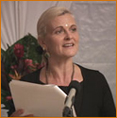 |
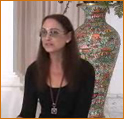 | | Ruchiradama Quandra Sukhapur Rani — Also known as Adi-Dasya Quandra Sukhapur Rani. A practitioner in the advanced stages of the Way of Adidam, and a member of the Ruchira Sannyasin Order (i.e., one of Avatar Adi Da's senior renunciate devotees). Among her previous names and titles are: Quandra Sukhamai and Kanya Tripura Rahasya. |
| Rudi — Swami Rudrananda (1928-1973). Avatar Adi Da Samraj's Spiritual Teacher from 1964 to 1968. Rudi (born Albert Rudolph) was a devotee of both Swami Nityananda and Swami Muktananda. Avatar Adi Da's discipleship with Rudi is described in His autobiography, The Knee Of Listening. | | 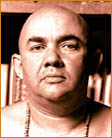 |
Sacrament of Universal Sacrifice — Participation in the Sacrament of Universal Sacrifice involves offering (in a mood of gratitude, love, devotion, and self-surrender) a gift to Avatar Adi Da (in Person or in the form of His Photographic Image), and receiving a Blessed gift, or "Prasad", in return. The giving and receiving of tangible gifts enacts the surrender of egoic self to Avatar Adi Da and the reception of His eternally Given Gift of the Divine "Brightness" in return.
sadhana — Sanskrit for "discipline", traditionally meaning "practices directed toward religious or Spiritual goals". In the Way of Adidam, sadhana is not action to attain Truth or any state or condition, but is, rather, action that expresses present, intuitive Communion with Truth. Such free action is always performed in conscious Divine Communion with Avatar Adi Da.
Adi Da used the phrase "Sadhana Years" to refer to His practice of submission to the spontaneous process of Re-Awakening to His Inherent Divine Nature that occurred before that process culminated on September 10, 1970.
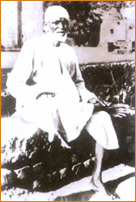 | | Sai Baba of Shirdi (1838-1918) — An Adept who lived and taught in the town of Shirdi, India for 64 years. He was considered by his Hindu and Muslim devotees to be a saint. Throughout his life he maintained the habits of a poor ascetic. He is one of the most popular of Indian saints and continues to have a large following. |

Sangha — Traditional word for the community of practitioners of a particular spiritual Way.
Sannyas, Sannyasa/Sannyasin — Sanskrit for "renunciation, renunciate". Traditionally this is a term for an ascetic renunciate, one who has relinquished all bonds and social obligation. In Adidam, sannyas, although exemplifying the renunciate disposition and practice, does not involve asceticism.
sarvadhikari — A term used by Adi Da to refer to a particular devotee who would assume responsibility for some area (for example, the worldwide culture) so completely that Adi Da would not have to be disturbed by any "religion business" in that area, and could instead completely focus on His functions as Guru. Thus, while a sarvadhikari had a specific management function (like managing the worldwide culture), in some sense his or her primary function was to act as a buffer between the world and the Guru, and keep the Guru from being disturbed (in accord with the traditional admonitions for Guru devotion, such as "Never disturb your Guru's mind.") Typically, Adi Da would be in direct communication with such a sarvadhikari every day. As a model for what a sarvadhikari should be, Adi Da used the example of Ramana Maharshi's brother, who one day simply assumed complete responsibility for Maharshi's Ashram, freeing up Maharshi to be the Guru only, and not a manager. Maharshi began using the term "sarvadhikari" for people who served such "general manager" functions in His Ashram, and Adi Da used the term in a similar manner, for a number of key functions.
Sat-Guru-Naama Mantra — Mantras composed of sacred names and sounds are used in the meditative practices and devotional ceremonies of many religious traditions. In the Way of Adidam, the principal Mantra, called the "Sat-Guru-Naama Mantra" is based on Adi Da's name, and is a powerful way of invoking Him. (Adi Da has given many variants of this single Mantra, including "Om Sri Adi Da Avatara Hridayam".) The Sat-Guru-Naama Mantra is used in a variety of occasions, including: - by priests performing the Sat-Guru Murti Puja and the Sat-Guru-Paduka Puja;
- at the end of a chanting occasion;
- at the end of a reading Of Adi Da's Word;
- at the end of cultural events or presentations, as an alternative to the Second Great Invocation;
- at the end of a period of the Devotional Prayer of Changes;
- when purifying a space with light and incense;
- when circumambulating a Holy Site;
- silently or sub-vocally by devotees during formal meditation and randomly during the day.
Satsang — Sanskrit for "true or right relationship", "the company of Truth". Satsang is the eternal relationship of mutual sacred commitment between Guru and devotee.
Second Great Invocation — The First Great Invocation and the Second Great Invocations are used to formally begin and end almost every kind of cultural event in Adidam, including daily Sat-Guru Pujas, meetings, and devotional groups. In general, everyone turns to a picture or Murti of Adi Da, and raises their hands, as they engage in the Invocation. The Second Great Invocation leader (often ringing a singing bowl):
Now let us offer the Second Great Invocation. all participants: Divine Heart-Master Adi Da Samraj, Realizer and Revealer Of The Heart, Revelation Of The "Bright" Divine Person, Hear my Heart-Call now. Bless me now with True self-Forgetfulness, By The Seven Gifts Of Remembering You, That my Heart May Grow In "Brightness" and Be Gone. I Hold Up my hands. ( All bow to Adi Da. The leader may strike a singing bowl three times.)
seeing — When, in the practice of the Way of Adidam, Hearing (or most fundamental self-understanding) is steadily exercised in meditation and in life, the native feeling of the heart ceases to be chronically constricted by self-contraction. The heart then begins to Radiate as love in response to the Divine Spiritual Presence of Adi Da.
This emotional and Spiritual response of the whole being is what Adi Da calls "Seeing". Seeing Adi Da is emotional conversion from the reactive emotions that characterize egoic self-obsession, to the open-hearted, Radiant Happiness that characterizes Spiritual devotion to Adi Da. This true and stable emotional conversion coincides with true and stable receptivity to Adi Da's Transcendental Spiritual Transmission, and both of these are prerequisites to further Spiritual advancement in the Way of Adidam.
self-contraction — Adi Da's technical term for the activity of separativeness that is the root of every apparent individual's suffering and seeking.
Seven Gifts — Since the early 1990's, Adi Da has taught that the Way of Adidam could be understood in terms of seven Gifts of Grace that He gives to devotees (and that are simultaneously Gifts and responsibilities, if fullest use is to be made of them): "My Seven Necessary Gifts Of Avataric Divine Grace (Given At Every Stage Of Practice In The Only-By-Me Revealed and Given Way Of The Heart, or Way Of Adidam) Are Word, and Sign, and Devotion, and Service, and Discipline, and Blessing, and Blessedness. . . Therefore, The Way Of Adidam . . . Is (Itself, and Altogether) A Gift From Me." (Epilogue, The Dawn Horse Testament). - Ruchira Avatara Vani — The Gift of the Word
- Ruchira Avatara Darshan — The Gift of the Sign
- Ruchira Avatara Bhakti — The Gift of Devotion
- Ruchira Avatara Seva — The Gift of Service
- Ruchira Avatara Tapas — The Gift of Discipline
- Ruchira Avatara Kripa — The Gift of Blessing
- Ruchira Avatara Moksha-Bhava — The Gift of Blessedness
The seventh (or Completing) Gift, the Gift of Blessedness (or Divine Enlightenment), is "Realized Only On The Basis Of The Right Present Fulfillment Of Each and All Of My First Six Gifts, and Callings, and Responsibilities Of The Way Of The Heart)." In the Second Great Invocation, devotees refer to the seven Gifts when they recite the line, "Bless me now with True self-Forgetfulness, By The Seven Gifts Of Remembering You, That my Heart May Grow In 'Brightness' and Be Gone." For more on the seven Gifts, read The Epilogue of The Dawn Horse Testament, and The Seven Gifts of Sri Da Avabhasa's Grace.
sexual conscious exercise — Adi Da's wisdom about sexuality includes a critique of conventional sexuality: the principal degenerative effect of conventional sex is the throwing off of bodily energy and (in the case of men) vital reproductive chemistry through genital orgasm. Adi Da explains that genital orgasm is not a benign (or necessary) bodily function, except when conception is intended. When randomly and repetitively allowed, genital orgasm is physically and emotionally negative in its effects, a fact one can become sensitive to over time. The search for genital orgasm is a learned response, and it is a reaction to the self-contraction, or the feeling of being alienated from Love, Happiness, and Divine Fullness.
Through the practice of sexual conscious exercise, practitioners of the Way of Adidam learn the art of converting sexuality into an expression of the fullness of Divine Communion, rather than a search to feel better. Devotees convert the energy of orgasm into a regenerative orgasm, a profusion of pleasure that permeates the whole body. As one adapts to the practice of sexual conscious exercise, one finds that one's addiction to genital orgasm and the other negative effects of conventional emotional-sexual conditioning begin to be purified.
A right understanding of sex (and associated practice of sexual conscious exercise) is crucial to growth beyond the first three stages of life. Nothing impedes our greater growth more than our seeking and clinging in the emotional-sexual area.
 | | Shankara (788-820) — One of the greatest Hindu sages, Shankara is considered the most famous exponent of the tradition of Advaita Vedanta. |
Siddha — "Siddha" is Sanskrit for "a completed, fulfilled, or perfected one", or "one of perfect accomplishment, or power". Avatar Adi Da uses "Siddha", or "Siddha-Guru", to mean a Transmission-Master who is a Realizer (to any significant degree) of Real God, Truth, or Reality.
Siddha Peetha — "Seat" ("Peetha") of the "great Spiritual Master" ("Siddha"). A term used to refer to one of Adi Da's Empowered Sanctuaries, particularly His primary Sanctuary, Adi Da Samrajashram.
Siddhi — A Sanskrit term which means Spiritual Power, both in the sense of Spiritual Force and in the sense of unique Spiritual Capability.
Siva / Shiva — A traditional Hindu name for the Divine Being Itself, or Divine Consciousness.
| Sivananda (1887-1963) — Swami Sivananda is one of the most well-known and well-respected Indian Yoga masters and Hatha Yoga teachers of the 20th century. | |  |
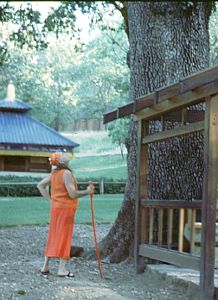
Adi Da blessing the Tree of Life at Skyway Temple, 1998 | | Skyway Temple — A holy site at The Mountain Of Attention. The center of this site is a tree, the "Tree of Life". The site is associated with characteristically male energy, and so is served principally by male devotees. It is associated with the nearby Earth-Fire Temple, which particularly expresses the nurturing-female dynamic of energies.
Skyway Temple is also the site of regular Prosperity Pujas. |
Source-Texts — The summary books of Avatar Adi Da's Avataric Divine Wisdom-Teaching, designated as part of His Eternal Message to humankind. While they are made available to all who are interested, Adi Da's Source-Texts are generally read by devotees; more introductory books are provided for the public. The Source-Texts presume a familiarity with Adi Da's extensive technical language, much as a graduate physics text in an area of knowledge presumes familiarity with everything already learned in high school and college physics education. In another sense, The Source-Texts are like the technical manuals used for reference by experts in any field; no one would read a manual, and mistake it for an introduction or a tutorial! Adi Da once told a devotee in charge of education to think of Him like Einstein. Einstein would come up with the breakthough insights and publish them in technical journals; but others (educators) had the responsibility to make these insights accessible to the public (for example, by writing articles in popular science magazines, or writing high school and college textbooks).
stages of life — Avatar Adi Da Samraj has described human life in terms of seven stages. The first three stages of life are assocated with the general human physical, emotional/feeling, and mental/will development. The fourth stage of life is the awakening of the heart, devotion, movement towards God. The fifth stage of life is associated with mystical ascent. The sixth stage of life is associated with Transcendental Realization. The seventh stage of life is associated with the realization of utter non-difference, perfect Realization of Consciousness Itself, Reality Itself.
| The seventh stage of life is not "seventh" in the sense of "following" the first six. The seventh stage of life Is Beyond and Prior to the first six stages of life. The seventh stage of life has nothing to do with "stages" of life. The seventh stage of life Is simply the Perfect Self-Demonstration of the Divine Reality-Truth, the Truth of the Divine Reality-Revelation. . . . The Always Already Self-Presence of Reality Itself Is the Secret upon Which right and true practice of the only-by-Me Revealed and Given "Radical" Reality-Way of Adidam Is Founded. |
For a more detailed description of the Seven Stages of Life, see our introductory article, or read Adi Da's book, The Seven Stages of Life.
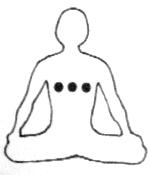 stations of the heart — One of the unique aspects of Avatar Adi Da's Revelation of the Way of Adidam is His complete description of the esoteric anatomy of the human being and how this relates to the Spiritual process. Just as the human body has a gross anatomy (of bones, flesh, nerves, and so on), there is also an esoteric anatomy, consisting of three primary structures. The esoteric anatomy of the human body-mind is the basis for all dimensions of human experience — of the ordinary, extraordinary, mystical, and Transcendental kind.
One of the structures of esoteric anatomy is what Adi Da calls "the three stations of the heart". The three "stations" are: - The "left side" — corresponding to the physical heart, and the gross dimension of the being.
- The "middle station" — corresponding to the "heart chakra" (or "anahata chakra"), and the subtle dimension of the being.
- The "right side" — which is the "seat" of the causal dimension (or root-dimension) of the being (equivalent to the primal presumption that one exists as a separate "self", or "ego"), and which is (simultaneously) the "doorway" in the body-mind through which the ego can be utterly dissolved, in heart-Identification with Avatar Adi Da.
As the practice of Adidam matures, the progressive Spiritual activation of each of the three stations of the heart can be tangibly felt.
The Spiritual Initiation that Adi Da Gives to His fully prepared listening devotees is His Spiritual Activation of the left side of the heart, which (in due course) also becomes His Spiritual Activation of the middle station of the heart. Avatar Adi Da's Spiritual Gift of the Samadhi of the "Thumbs" is what makes possible His Spiritual Activation of the right side of the heart, which is coincident with the practitioner's entrance into the "Perfect Practice" of Adidam.
The "root" and foundation of esoteric life is at the human heart. And the human heart is a complex mechanism. It has three primary regions. One is associated with your ordinary emotions and the physical action of the heart, and that is, it could be said, on the left side. In the center, there is the dreamer, the feeling dreamer, the place of visions. And on the right side — associated with the "pacemaker" that generates the heartbeat all across the chest, from right to left in rhythms — is the "root" of consciousness, the ultimate profundity of emotion. When all three of these are awakened, and not just one, you are alive in Absolute Unity with the Self-Radiant and Self-Existing Divine Being. And This True Heart — Which is not merely the heart chakra, not merely the heart on the right, not merely the physical heart and the round of conventional emotions, but This Great and Fundamental Being — Is the Foundation of esoteric practice. And it is from This True Heart that energies are Shined in the brain, Shined to the crown, Shined throughout the nervous system, Shined to the feet, Shined to the bodily base.
What is sought to be Realized at the end of the course of Yoga is This True Heart. But what a pity to have to go through the entire process only to Realize It at the end, when It is, Itself, the Foundation of true practice, when It is, Itself, the Foundation of Realization. Why work to the end to Find God when you can make Communion with Real (Acausal) God the very basis of practice, when you can make Real-God-Realization the content of your life of practice? This is My Question to you, and this is a "Consideration" fundamental to My Reality-Teaching.
Avatar Adi Da Samraj |
Because there is not a "downward-and-upward" quality (as in the circle of conductivity) to the three stations of the heart, Avatar Adi Da refers to them as the horizontal dimension of esoteric anatomy. A minority of the world's Spiritual traditions (principally certain branches of the Hindu, Buddhist, Jain, and Taoist traditions) are focused in processes that relate to the horizontal dimension (and especially the right side of the heart) — seeking, as an ultimate result, an "interiorly secluded" Identification with the Divine (or Realization of Truth). In the fullest development of this "horizontal" approach, the practitioner does, in fact, experience an Identification with the Divine (or a Realization of Truth) that is achieved by excluding all awareness of body and mind and world. Such exclusive Union with the Divine, however, is not permanent (or eternal), because it depends on the effort of the individual: the effort to "go within", or to exclude everything that is apparently objective. Thus, such exclusive Union with the Divine is not most perfect Divine Enlightenment. Rather, it is a choosing of the "Consciousness" aspect of the Divine over the "Light" (or "Energy") aspect.
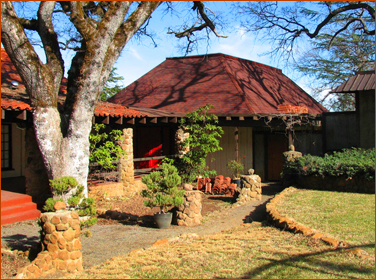
the Sukra Kendra at The Mountain Of Attention |
Sukra Kendra — Out of all the holy places and temples He has established at each of His Hermitage Sanctuaries (and at the European Danda), the Sukra Kendra is the most sacred of all the temples, set apart for Adi Da's (often daily) use in His Work of World-Blessing. As Adi Da described it, "I Am eternally seated in each and every one of My directly-by-Me Transcendentally-Spiritually-Empowered Sapta-Na Sannyasin Hermitages and Ruchira Sannyasin Sanctuaries — and most potently in each and every one of the Sukra Kendras I have established in those Hermitages and Sanctuaries." Often Adi Da would place objects or gifts that He wanted to Bless in the Sukra Kendra Temple for a period of time. There are four Sukra Kendras on Naitauba, and one at each of the other Sanctuaries. One of the Sukra Kendras on Naitauba is right above the Samadhi Chamber where Adi Da's body is located at the Outshining "Brightness" Temple. My Sukra Kendras are My Houses, My Places in this realm, usable to Me even after the lifetime of this body. They must be preserved as My Houses. Any time in the future, even 10,000 years from now, the attitude of devotees must be: "The Master lives there. The Master maintains His Focus on Earth here. We must preserve these Holy Places."
Presume them just as My Houses. That is where I Live for all time, always Focusing My Power of Divine Avataric Self-Manifestation through these unique Places.
Everything must be done to preserve My Sukra Kendras and to keep them from being intruded upon. Devotees are not to be casually invited into My Sukra Kendras. My Sukra Kendras are the province of the Ruchira Sannyasin Order. Devotees, in general, are simply obliged to make sure that these Places are maintained and preserved.
Avatar Adi Da Samraj |
| tamboura — A long necked plucked lute from India, used for creating a very rich drone (or steady sound) that serves as the ground for all the other instruments. The tamboura's bodily shape somewhat resembles the sitar, but it has no frets, as only the open strings are played as a harmonic accompaniment or drone to the other musicians. | |  |
tapas — A Sanskrit term meaning "heat". "Tapas" is most often used in relation to the effects inherent in the frustration of tendencies through self-discipline. This can be literal physical heat, or the emotional and psychic sense of friction, going against the grain, self-restraint.
 | | Tat Sundaram — One of Adi Da's five Hermitages and Sanctuaries, located in northern California. More can be found here. |
| Taveuni — The third largest Fijian island; the last travel stop on the way to Adi Da Samrajashram, the island of Naitauba, via boat. (Taveuni is about 40 miles from Naitauba.) | | 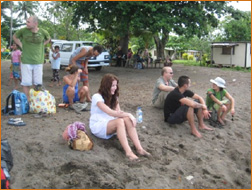
devotees waiting for the boat from Taveuni to Naitauba |
Tcha — Adi Da's characteristic sound of spontaneous Blessing.
Third Congregation — Avatar Adi Da has created four congregations in order to make it possible for all types of people to enter into devotional and Spiritual relationship to Him — both those who are moved to practice the Way of Adidam in the fullest and most profound manner (first and second congregations) and those whose life-circumstance makes it right and appropriate for them to practice a simpler form of the Way of Adidam (third and fourth congregations). Members of the Third Congregation are individuals from all walks of life who have a clear sympathy, admiration and respect for Avatar Adi Da and are moved to support His Work in the world, without currently taking up the full practice of Adidam Ruchiradam, although that is their expressed longterm intention. The Third Congregation is also known as "The Society of Advocates". This is in keeping with the great esoteric spiritual traditions throughout history. It was traditionally understood that if one isn't ready to take up the practice itself, then the next most auspicious thing one can do is to serve the work of the Spiritual Master in the world. For this reason, one of the principal services of a member of the Third Congregation of Adidam is advocacy — effectively advocating Avatar Adi Da in the world — through one's individual skills, position, or professional expertise. In this way, members of the third congregation can make an extremely important contribution to Avatar Adi Da's work in the world by making Him known in all areas of society.

after putting on the third hat |
the "third hat" — When He first moved to Naitauba in 1983, Adi Da was given three hats by devotees. He said He would only put the third hat on when He was absolutely certain that He could fully do His Work in this place given to Him by devotees. When one of His devotees secured Fijian citizenship for Him on October 23, 1993, Adi Da put on the third hat in a great celebration with devotees.
the "Thumbs" — The psycho-physical experience of fully receiving the descent of Avatar Adi Da's Spiritual Presence, leading to a profound, self-forgetting absorption in Him.
The "Thumbs" is named after an experience that Avatar Adi Da also began to notice as an infant. He would feel a sensation of intense pressure, coming down into His body and His throat. He describes that it felt like huge thumbs pressing into His body from above. The experience was very powerful, and often He would feel an overwhelming gagging sensation associated with it. Later in life, He was able to consciously allow this experience to reveal its full meaning: The "Thumbs" is His "Bright" Condition appearing as Spiritual Force, pressing into the world of physical appearances. This Divine Pressure is actually the "Transmission", or pervading Energy, of the "Bright". It literally transforms and awakens the presumed separate "self" or "person" to the unchanging and non-separate Truth of the "Bright".
| Tilopa (989-1069) — A Crazy Wisdom Adept of Tibet in the Buddhist tradition that began in India and flowered in Tibet. He is the originator of the teaching that formed the backbone of the Kagyu lineage of Tibetan Buddhism. Tilopa is said to have been taught and enlightened by dakinis, or Spirit Goddesses. Tilopa's primary disciple was Naropa. | |  |
Transcendental Spiritual — A principal reference used by Adi Da to indicate the unique nature of the Revelation, Realization, and Way available in His Company.
 Spiritual. A process is "Spiritual" if it involves a tangible, Grace-Given Spiritual Transmission pervading the body-mind. Such Spiritual Force is conducted in "the Circle of conductivity". "Fourth stage" practices are associated with the descent of Spiritual Force down the frontal line of the body. "Fifth stage" practices are associated with the ascent of Spiritual Force up the spinal line of the body. The ultimate Realization associated with the traditional Spiritual practices is fifth stage conditional Nirvikalpa Samadhi, the ascent to perfect communion with the Matrix of Light infinitely above the head. Adi Da summarizes these practices in His book, The Pneumaton Spiritual. A process is "Spiritual" if it involves a tangible, Grace-Given Spiritual Transmission pervading the body-mind. Such Spiritual Force is conducted in "the Circle of conductivity". "Fourth stage" practices are associated with the descent of Spiritual Force down the frontal line of the body. "Fifth stage" practices are associated with the ascent of Spiritual Force up the spinal line of the body. The ultimate Realization associated with the traditional Spiritual practices is fifth stage conditional Nirvikalpa Samadhi, the ascent to perfect communion with the Matrix of Light infinitely above the head. Adi Da summarizes these practices in His book, The Pneumaton ("The Book of Spirit"). Transcendental. A process is "self-transcending" if it is associated with transcendence of some aspect of the body-mind self complex. Different practices are associated with different forms and degrees of self-transcendence. Generally one is identified with the "body". Some self-transcending practices enable one to stand as the subtle body (or "mind"), transcending the physical body. Some enable one to stand as the causal body (or "self"), transcending both mind and body. And some practices — the Transcendentalist practices — allow one to stand as Consciousness Itself (in the Realization known as Jnana Samadhi), prior to the entire body-mind-self complex. In terms of esoteric human anatomy, that Realization is associated with the right side of heart. The Transcendentalist practices and Realizations are associated with what Adi Da calls the sixth stage of life. He summarizes these practices in His book, The Gnosticon ("The Book of Knowledge"). Transcendental Spiritual. The Spiritual traditions and the Transcendentalist traditions each realize part of Reality, to the exclusion of the rest of Reality: the Spiritual traditions enable perfect Communion with Light, but without the Realization of Consciousness; the Transcendental traditions enable perfect Identification with Consciousness, but without the Realization of Light. Adi Da's seventh stage Realization is that of Conscious Light — the simultaneous Realization of both Consciousness and Light ("Shiva" and "Shakti"):  one is identified with Consciousness Itself, but one also recognizes all things and beings as a modification of Consciousness Itself. Thus Adi Da refers to this Realization as "Transcendental Spiritual". In terms of esoteric anatomy, the Realizer is simultaneously associated with the right side of the heart and the Matrix of Light infinitely above the head; the radiant, S-shaped, esoteric channel known as Atma Nadi (see right), that links the right side of the heart with the Matrix of Light above has been awakened and regenerated. Adi Da's seventh stage, Transcendental Spiritual Realization and Revelation is unique in the history of the world's religious and spiritual traditions. It is now Realizable by all through the practice of the Reality-Way of Adidam. Adi Da summarizes the seventh stage Realization and Way in His book, The Aletheon ("The Book of Truth"). God-Realization. All the great Realizations of the esoteric traditions are associated with some form of God-Realization. The Spiritual traditions Realize God as Light; the Transcendentalist traditions Realize God As Consciousness; and the Transcendental Spiritual tradition of Adidam Realizes God as Conscious Light.
Turaga — In Fijian, "Turaga" denotes the chief of a village, clan or tribe.
To the native Fijians of Naitauba, Avatar Adi Da Samraj is known as "Turaga Dau Loloma Vunirarama", "The Great Lord [Turaga] Who Is The Divine Adept [Dau] Of The Divine Love [Loloma] and The Self-Radiant Divine Source and Substance [Vu] Of [ni] The Divine 'Brightness' [Rarama]".
Universal World-Prayer — On April 8, 1999, Adi Da created a prayer for use by all of humankind. He described it as "A Prayer To The Heart Of Reality, Proposed By The Divine World-Teacher, Ruchira Avatar Adi Da Love-Ananda Samraj, For Non-Sectarian Use By All Of Mankind". Here is the prayer: Beloved, Inmost Heart of every heart,
do not Let our human hearts be broken
by our merely mortal suffering here—
but Make our mortal human hearts break-Free
to an unconditional love of You,
that we may, Thus, love all living beings
with Love's own True, and Truly broken, Heart. |
Upanishads — The Upanishads, of which there are over two hundred, are principal Scriptures of Hindu esotericism. They record the wisdom of non-dualism. The oldest Scriptures of the genre date back to the eighth century B.C.E, while the most recent Upanishads belong to this century.
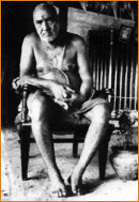 | | Upasani Baba (1870-1941) — Born and raised in India, Upasani Baba renounced his medical profession, together with his worldly life, at the age of 40. In a short span of time, with the blessings of Narayan Maharaj and Sai Baba of Shirdi, he attained great Spiritual Realization and became an Adept in his own right. He was a wild, eccentric character. Upasani's Way was founded on devotion to the Guru, and he also manifested higher Yogic powers. Although Upasani Baba left no written Teaching, many of his talks have been published. |
Vajrayana — The Vajrayana is often viewed as the third major "vehicle" (Yana) of Buddhism, alongside the Theravada (the first vehicle) and Mahayana (the second vehicle). Vajrayana Buddhism evolved in Tibet from Mahayana Buddhism.
Vedas (adjectival form: "Vedic") — The most ancient and sacred of Hindu scriptures, considered the oldest surviving scriptural texts in the world.
| Vedanta Temple — Also known as the Vedanta Society Temple. A small temple in Hollywood, California, belonging to the Vedanta Society of Southern California, and dedicated to the Indian Realizer Ramakrishna. Avatar Adi Da discovered this temple when He was living in Los Angeles in 1970, and it was here that Adi Da's years of Sadhana culminated in His Divine Re-Awakening. | | 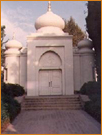 |
Vision of Mulund — During Adi Da's first trip to India in April, 1968, He visited the small town of Mulund, just outside Mumbai (Bombay). His first impression was "a little dirt-roaded village with crowds of people — not a beautiful place." He later climbed to the roof of the small apartment building where He was spending the night. He described (in 1988) what He saw from the roof, which was clearly a waking vision, which He would later refer to as "the Vision of Mulund":
There was no way I could have presumed that anything like what I saw existed in this town. It was a large square with green at the perimeter. Everything was cleanly trimmed. There were decorative trees and plants and flowers everywhere, and walkways through a large park where a few people were calmly walking about, all of them very crisply and cleanly dressed in a style of clothing I suppose is characteristic of this group. They were all well washed and clean in their nice evening dress — families, women and children and men, walking together very calmly. There was no sound, no noise at all, in the park — whereas it was all noise beyond at the front side of the building.
The park was a picture of serenity and order, of people who lived effectively, people who could choose a way of life and by cooperation with one another command the quality of life that they chose.
It was quite different from what one sees elsewhere, in the little dirt-road towns that are called "cities" in the world, with all the noise and chaos of "put up with whatever your neighbor feels like doing" and "we all just do our thing". In such places, everybody puts up with what everybody else is doing. You hang a picture or set out a little vase of flowers, put in earplugs, and try, in your sheerest privacy and in the smallest place that you can call your own, to create something of the order of your own choosing.
Very few people have the chance to choose an order together, a way of life that is based on the Truth. Rather, everyone is wandering, doing their thing, ego-wise, and disturbing everyone else.
One of the virtues, then, of My devotees' choosing to practice the Way of Adidam together is that you can command the quality of space and time, at least on a much larger scale than you could otherwise, and more surely. If you do that, then your environments can become beautiful places where that order, that serenity, that quality of life that you live in My Company is shown, as well as places that are a sign of God-wardness and Divine Awakeness, or the Process that Awakens toward God and in God, and Most Ultimately As God.
Avatar Adi Da Samraj, July 2, 1988 |
Adi Da based key elements of "Adidam cooperative community" on this Vision, and also named certain Adidam organizations after it (including The Vision of Mulund Institute, which provides education and other resources to support the human and Spiritual growth of children and young adults).
Vitals, Peculiars, and Solids — Adi Da describes three human character types. All three strategies appear at one or another moment in every individual, even though one strategy may be especially characteristic of the individual.
The “vital” type tends to indulgence of the body. Vitals have a chronic tendency to fix attention in the physical dimension. Vitals are focused in the present moment and are principally concerned with how they are going to be made happy in the body “right now”. Many vitals feel a desire to rebel and feel too controlled by others. They are often loud, full of energy and enthusiasm, but can also be very lazy and moody. The fundamental emotion associated with vitals is anger. The vital person is a negative development of the quality of expansive energy.
The “peculiar” type is mostly preoccupied with emotions and what he or she is feeling. Peculiars have a chronic tendency to fix attention in the etheric or emotional-sexual dimension. Peculiars are focused in the past and are often very sentimental and romantic about what has happened to them. Because peculiars tend to feel neglected they welcome controlling influences in their lives. Peculiars can have dramatic mood swings between being really happy and being really depressed. The fundamental emotion associated with peculiars is sorrow. The peculiar person is a negative development of the quality of balance, based on an inversion of both physical and mental tendencies.
The “solid” type has a hyperactive mind and is generally out of touch with his or her emotions. Solids are always thinking ahead to the point of “living” in the future. They like everything to be in order and often want to control their own body and others. The fundamental emotion associated with solids is fear. Solids have a chronic tendency to fix attention in the lower mental dimension. The solid person is a negative development of the quality of inwardness, or passive inversion.
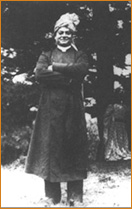 | | Vivekananda, Swami (1863-1902) — The principal disciple of Sri Ramakrishna (1836-1886), the modern Indian saint whose teaching he made widely known in the West. Avatar Adi Da Reveals the unique Role of Swami Vivekananda (and Vivekananda's Guru, Ramakrishna) as the Deeper Personality Vehicle of Avatar Adi Da's Avataric Incarnation in His autobiography, The Knee Of Listening. |
Witness, Witness-Position, Witness-Consciousness — When Consciousness is free of identification with the body-mind, it takes up its natural "position" as the Conscious Witness of all that arises to and in and as the body-mind.
In the Way of Adidam, by considering Adi Da's Teaching about it, one can have intuitions of the Witness-Position at any time. But the stable Realization of the Witness-Position is associated with, or demonstrated via, the effortless surrender (or relaxation) of all the forms of seeking and all the motives of attention that characterize the first five stages of life.
Identification with the Witness-Position is not final (or Most Perfect) Realization of the Divine Self. Rather, it is the first of the three stages of the "Perfect Practice" in the Way of Adidam, which Practice, in due course, Realizes, by Avatar Adi Da's Grace, complete and irreversible and utterly Love-Blissful Identification with Consciousness Itself.
For more about the Perfect Practice, click here.

Adi Da visiting and Blessing Stonehenge during His world yajna in 1986. |
Yajna — Sanskrit for "sacrifice" (particularly in the context of a fire sacrifice). The term is generally used in Adidam to refer to Avatar Adi Da's travels away from His Hermitage Sanctuaries. During these travels, He would Bless the world and all beings through His contact with many people and places. Such travels represented a profound sacrifice on Adi Da's part, because, by His Divine (non-separate) Nature, He would absorb the karmas of anyone He came into contact with, taking them on and dissolving them in His own body (which suffered profoundly from that), and coming into contact with large numbers of public people magnified this to a far greater degree than coming into contact with His own (relatively more prepared) devotees.
Occasionally, the term is used by extension to refer to the travels of a sacred object, for example: "The Hanuman statue arrived at Da Love-Ananda Mahal after completing a Yajna of holy sites in India."
yaqona — The Fijian name for a root (known elsewhere in the South Pacific as "kava") which is used to create a drink that is central to traditional Fijian ceremonies.
Yoga (adjective: Yogic) — As Adi Da uses it, a generic term referring to a spiritual practice, or to a mental, physical, or emotional discipline supporting spiritual practice. The physical exercises many people think of when they hear the term, yoga, are actually only one of many different "yogas" (the one known as hatha yoga) in the Indian tradition.
Yuga — A Hindu term meaning "age" or "epoch". In the Hindu view, the history of the universe proceeds through a sequence of four yogas (called a kalpa), and is then destroyed and recreated. The cycle repeats endlessly. The yugas are: the Satya Yuga (the golden age); the Treta Yuga (the silver age); the Dwapara Yuga (the bronze age); and the Kali Yuga (the iron age). The names come from throws of the dice in an Indian game of chance. The sequence of yugas is associated with a gradual decline of wisdom, and the loss of direct awareness of the greater-than-material Reality and direct awareness that one has more "bodies" than just the material body. In the Kali Yoga, degenerate living (organized around fulfillment of the material body only) is at its greatest. The Hindu view is that we are currently in the Kali Yuga. Adi Da also often uses the term, "Kali Yuga" (or His own phrase, "late-time") to refer to the period in which we are currently living. Hindu scripture suggests that, in the Kali Yuga, Vishnu will incarnate as a great Avatar, the Kalki Avatar, who will bring an end to the Kali Yuga and restore the Satya Yuga. Various prophecies have Him doing that either by destroying the universe, or through a more benign process that leaves the universe intact, but destroys the wicked. Adi Da comments on His Own appearance here in this "late-time", in a conversation with a devotee: DEVOTEE: Is there something different about Spiritual practice in this time? Traditionally, it is has been said that it is more difficult to practice in the Kali Yuga.
AVATAR ADI DA SAMRAJ: Absolutely not. This "late-time" (or "dark" epoch) has its particular signs and characteristics, but you should not call it any kind of "bad yuga" in order to justify your weakness in practice of the Way I Reveal and Give. Relative to what is required in order to practice, all yugas are, fundamentally, the same. The fundamental process of ego-transcendence is always required, no matter what the characteristics of the times, or the characteristics of the experience of the individual at any time. And, even though the present epoch is relatively "dark" and the time is "late", I Am here!
I have Destroyed the impediment in this "late-time" — by My Avataric Divine Descent and Avataric Divine Self-"Emergence", here and everywhere in the entire Cosmic domain. Therefore — now, and forever hereafter — it does not make the slightest bit of difference what yuga it is, because I Am here — now, and forever hereafter. Because I Am here, the "circumstance" of necessary ego-transcending practice is the relationship to Me. That is certainly the case for all who heart-recognize Me, and who heart-respond to Me by embracing the only-by-Me Revealed and Given Way of Adidam.
Because of your relationship to Me, the so-called "Kali Yuga" has no negative power over you — none whatsoever. You are not bound by some sort of mysterious vibration of yuga-made ignorance, such that you cannot heart-respond to Me. For My true devotee, all time is — now, and forever hereafter — My time. |
|


186,104 people have liked our site's pages and shared them with their Facebook friends - Most Shared Pages
© 2025 Copyrighted materials used with the permission of The Avataric Samrajya of Adidam Pty Ltd, as trustee for The Avataric Samrajya of Adidam. All rights reserved. None of these materials may be disseminated or otherwise used for any non-personal purpose without the prior agreement of the copyright owner. ADIDAM is a trademark of The Avataric Samrajya of Adidam Pty Ltd, as Trustee for the Avataric Samrajya of Adidam.
Technical problems with our site? Let our webmaster know.